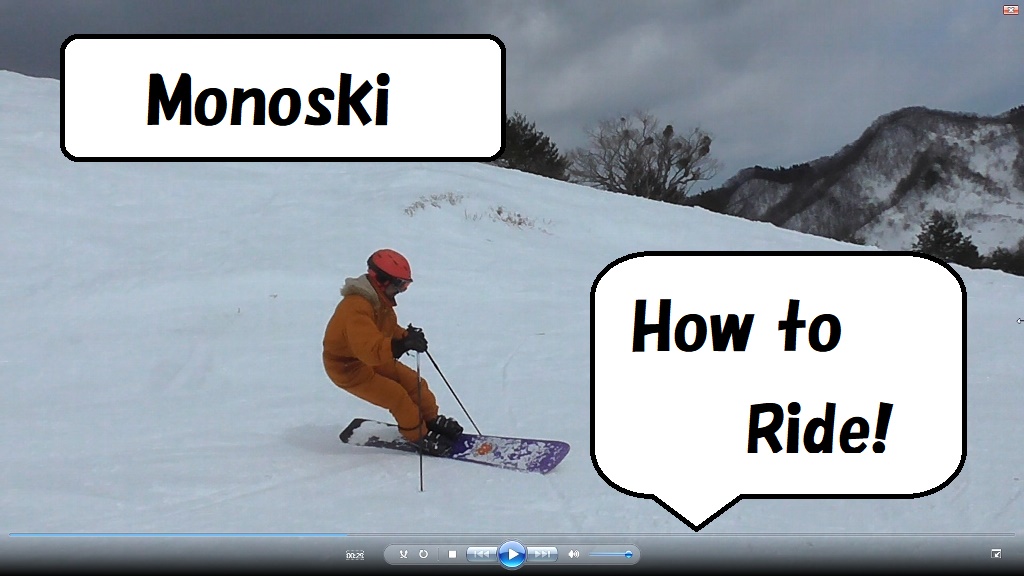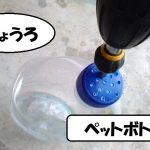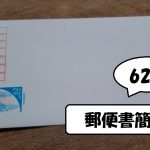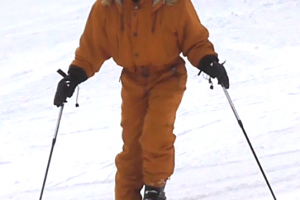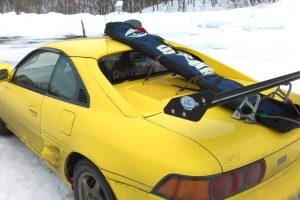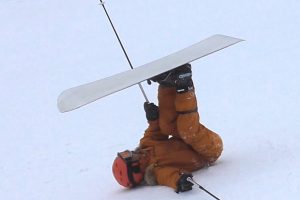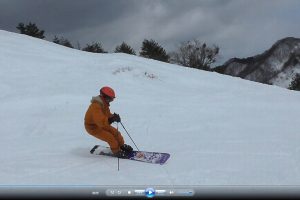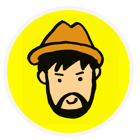目次をご覧になりたい方はクリックしてください→
- 1 What’s the “Monoski”?
- 2 First
- 3 Both-legged ski (normal ski, 2-legged ski)
- 4 Side-slip (on the slope)
- 4.1 Close-up
- 4.1.1 Raise the board. The edges works. (There are the angles between the boards and snow surface)
- 4.1.2 Flatten the boards. The edges lie down. (The boards and snow surface become near parallel.)
- 4.1.3 Raise the board. The edges works. (There are the angles between the boards and snow surface)
- 4.1.4 Flatten the boards. The edges lie down. (The boards and snow surface become near parallel.)
- 4.1.5 Close-up of the boards.
- 4.1.6 Flatten the boards. The edges lie down. (The boards and snow surface become near parallel.)
- 4.1 Close-up
- 5 One-legged ski (one board)
- 6 Practice schedule
- 7 Side-slip (on the slope)
- 7.0.1 Lift the top foot. Side-slip on the bottom foot (board).
- 7.0.2 Lift the bottom foot. Side-slip on the top foot (board).
- 7.0.3 • Now, you change the attitude to opposite.
- 7.0.4 Failure cases:Lift the bottom foot. Stand on the top foot (board). Fall down to the “top” as the edge bites the snow surface.
- 8 Traverse (diagonally downwards)
- 9 Turn (dynamics)
- 10 Turn of the one-legged ski
- 10.1 1. Top foot > Bottom foot (out-edge > in-edge) : Switch the edge on one board
- 10.2 2. Bottom foot > Top foot (in-edge > out-edge) : Switch the edge on one board.
- 10.3 3. Top foot > Top foot (out-edge > out-edge) : Switch the board
- 10.3.1 Incline the hips and the knees to the “bottom”. Incline the head and the upper body to the “top”.
- 10.3.2 Incline the hips and the knees to the “outside of the turn”. Incline the head and the upper body to the “inside of the turn”.
- 10.3.3 • moment of turn
- 10.3.4 • Switch the board (Ride on the other board)
- 10.3.5 Outside view camera
- 10.3.6 Katu-karē
- 11 Monoski
- 12 Side-slip (on the slope)
- 13 Traverse
- 14 Turn
- 14.0.1 • Entry
- 14.0.2 • Preparation of turn
- 14.0.3 • Reduce the load. Extension. Release the twist. → The board turns.
- 14.0.4 • Switch of the edge
- 14.0.5 • the latter part of turn
- 14.0.6 “Head (face) and the upper body (breast) face to the bottom“
- 14.0.7 “Always face to the bottom” ↓ Consequently “you unintentionally face outside of turn at times”
- 14.1 • Attitude of traverse at entry
- 14.2 • Case of a turn followed by the next turn
- 14.3 To turn continuously.
- 15 Attitude, CG (Center of gravity)
- 16 How to tumble
- 17 How to get up
- 18 Scene of Monoski
- 19 Well, let’s make your debut of “Monoski” next winter!
- 20 Monoski goods, gear
- 21 Difference of Monoski from normal ski
- 22 Attractiveness of Monoski?
- 23 Q&A
- 24 Others
- 25 How to carry the Monoski
- 26 Gallery
- 27 Ombara ski area
- 28 Editor’s postscript
- 29 Popular article
“Monoski” “one board” “Snowboard lengthways?”
Jump to Contents page here as this page is too long.
Jump to the Japanese page if you want. 日本語で見たい方はこちらをクリック。
What’s the “Monoski”?
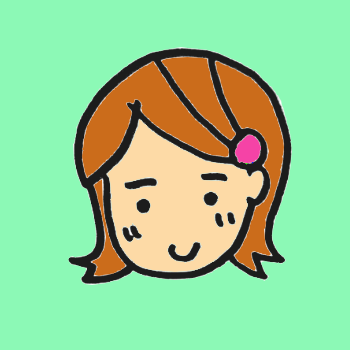

A music will begin.
“From a sidewalk Cafe” by Frank Mills. It’s me “Ojisan” playing the guitar.=^^=
It’s not my native language.
There would be sentences difficult to understand.
Because it’s “Japanglish”, I mean Japanese English. =^^=
Please “Guess” what I want to say with help of photos and videos, if any. (^^)
First
This page is rich in content and very long.
I’ve bored ski, then changed to snowboarding. I’ve also bored snowboarding, then changed to monoski.
It took several years to be able to ride monoski.
I think you can’t read through, unless you are “monozuki (curious person in Japanese word) “, then please watch videos thereafter read pages you’re interested in.
This is a textbook for monoski, but I think there may be useful content for normal ski (2-legged ski) much.
It may be more about 2-legged ski than monoski.
You cannot monoski first, you must try it patiently.
I mean “take it easy!”
If you got bored or felt difficulty, please return your favorite sports such as ski or snowboarding.
If you want to try another winter sports, please try monoski again.
I hope monoski freaks will increase reading this page.
monoski=mono (one) + ski
mono:”1″ in Greek
e.g. mono-rail, mono-tone, mono-logue, and so on.
Both-legged ski (normal ski, 2-legged ski)


Click here if you want to see “How-to-Monoski” right now.
Terms
Terms. In this page. Not formal.
top:upper slope. where you skied before.
bottom:lower slope. where you will ski down from now on.
top foot:upper foot when you stand the slope sideways.
bottom foot:lower foot when you stand the slope sideways.
outer foot:foot outside turn
inner foot:foot inside turn
in-edge:inside edge of ski. i.e. big toe-side.
out-edge:outside edge of ski. i.e. little toe-side.
the edge works:raise the ski board. the edge takes effect. get the ski near vertical to snow surface and the edge bites the snow.
the edge lies down:lay down the ski board. flatten the ski board. release the edge. get the ski near horizontal to snow surface.
reduce the load:reduce your weight to the ground (snow surface) jumping or extending your body from compressed attitude.
The contact pressure of the board and snow surface cause to reduce friction force and then you can turn the board easily.
You can’t turn the board if the board and snow surface are stuck.
Or you can’t turn the board if the edge of the board bite snow tightly.
Side-slip (on the slope)
Close-up
Raise the board. The edges works. (There are the angles between the boards and snow surface)
(from you. right is top. left is bottom. The skis will slip to the left.)
The edges bite snow surface. The skis can’t slip.
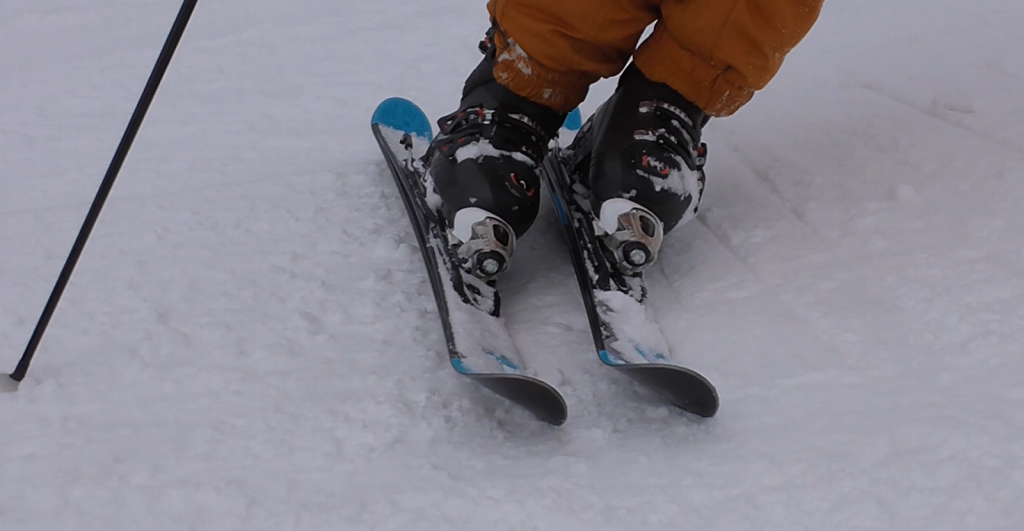
Flatten the boards. The edges lie down. (The boards and snow surface become near parallel.)
The edges don’t work. So the boards begin “side-slip” to the bottom (lower direction).
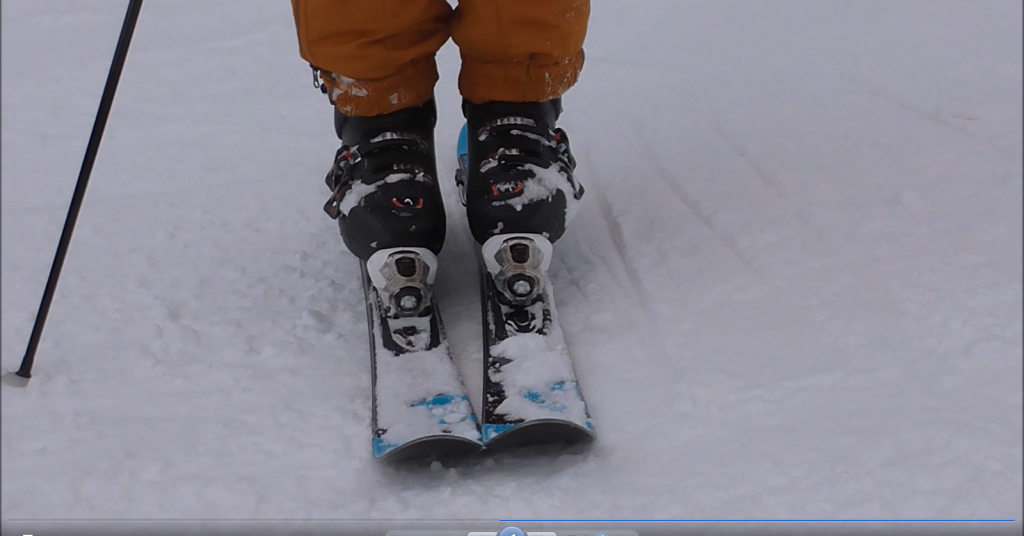
Raise the board. The edges works. (There are the angles between the boards and snow surface)
(from you. right is top. left is bottom. The boards will slip to the left.)

The hips and the knees incline to the top.
The head and the upper body incline to the bottom.
You stand unknowingly like this when you stand on the slope.
Flatten the boards. The edges lie down. (The boards and snow surface become near parallel.)
If you want to side-slip, you must flatten the boards.
You must take an opposite attitude with above.
Incline the hips and the knees to the “bottom”, the head and the upper body to the “top”.

The edges release the snow and begin to side-slip to the “bottom”.
Take the attitude above to stop the side-slip.

Watch video. ↓
Close-up of the boards.
You can understand the direction of the slope is opposite, can’t you=^^=
(from you. left is top. right is bottom. The boards will slip to the right.)
Flatten the boards. The edges lie down. (The boards and snow surface become near parallel.)
(from you. right is top. left is bottom. The boards will slip to the left. No problem you can’t hear my voice. I explain with letters.)


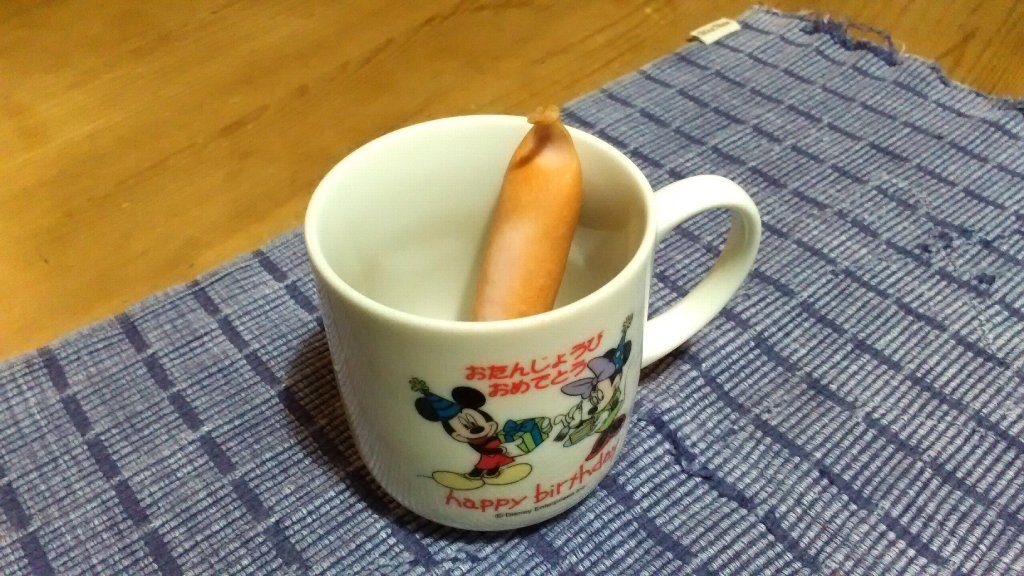
I’ve thought “Wiener coffee” like this. (^^)
We have the coffee named “Wiener coffee” here in Japan.
We say “Wiener” as “sausage” in Japan.
We use the word “Wiener” for “like Vienna”, but you say “viennese” in English, don’t you?
One-legged ski (one board)
First, we’ll begin with one-legged ski
Skiing scene
Please watch the video first as you may not have seen the one-legged ski, have you?
Only with one-leg, you ski alternating the edges right and left. Alternate in-edge and out-edge.
from the front
I’m skiing on the right leg in this video.
It’s easier when the right foot is the “bottom” i.e. you ride on the in-edge (inside the center of your body–big toe side) , but more difficult when the right foot become the “top” foot i.e. you ride on the out-edge (outside your body–little toe side).
You must incline the hips and the knees extremely to the “bottom”, the head and the upper body to the “top” or you’ll fall down to the “top” because the out-edge bite the snow surface.
Chasing view
the video of a chaser
Inside-leg ski. Alternate the board. Out-edge throughout.
from the front
You alternate the board.
You normally ride on the “in-edge (big toe side)” of the outside board of the turn.
Opposite,
You ride on the “out-edge (little toe side)” of the inside board of the turn throughout.
Incline the hips and the knees to the “bottom”.
Incline the head and the upper body to the “top”.
and
Incline the hips and the knees to the “outside of the turn”.
Incline the head and the upper body to the “inside of the turn”.
The head and the upper body unnaturally incline to the inside of the turn, but this is the basic attitude of the “inside-leg ski” “Monoski” therefore you must consciously make this attitude and position.
Chasing view
“Inside-leg ski” from chaser.
Opposite to the normal ski,
Do Watch care that
The hips and the knees incline to the “outside of the turn”.
The head and the upper body incline to the “inside of the turn”.
Or you’ll fall down to the inside of the turn (little toe side) as the “out-edge” bite the snow.
Practice schedule
First, let’s begin with “side-slip”.
Side-slip (on the slope)
Lift the top foot. Side-slip on the bottom foot (board).
(from you. left is top. right is bottom. The boards will slip to the right.)
CG (the center of gravity) is between your legs when you stand on the slope.
The in-edge of the “bottom” rises (or works, or take effect) not to “side-slip” biting the snow surface.
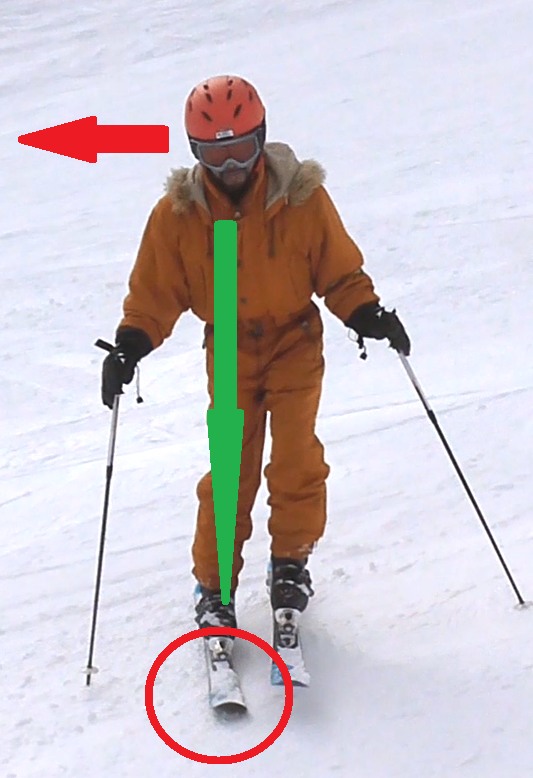
If you incline the head and upper body to the “bottom” and CG move to the “bottom” foot, the edge spontaneously lies down (flatten) and the board begin to “side-slip” to the “bottom”.
CG stay above the bottom foot or little beyond it.
Side-slip the bottom foot to the bottom, then CG return above the bottom foot.
So you can recover the balance again.
If the bottom foot doesn’t side-slip, you’ll fall down to the bottom as CG pass over the bottom foot.
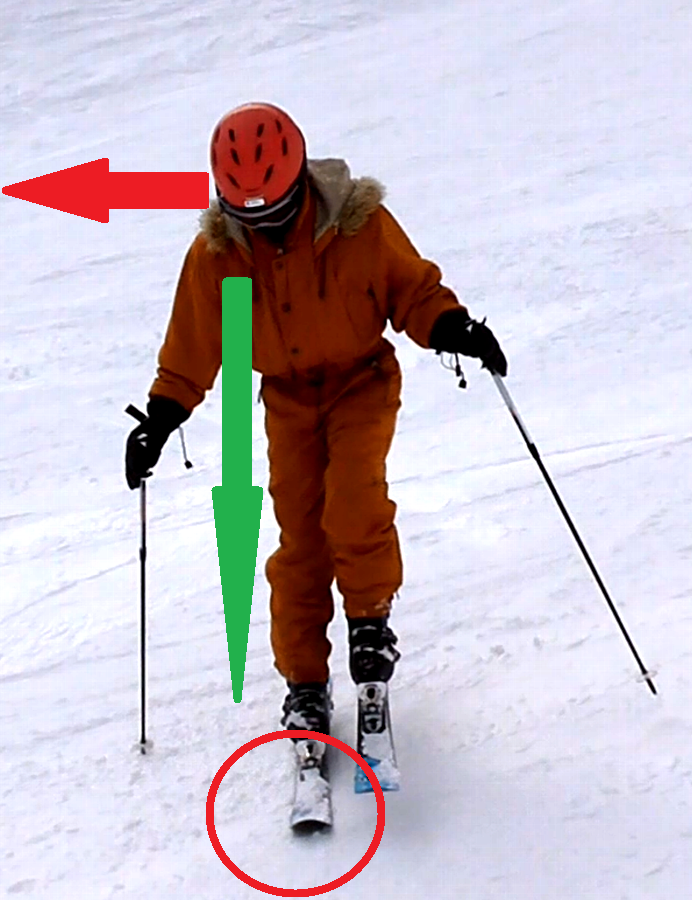
You slip the bottom foot (board) more so that CG move to the top, and then raise the edge.
Then you can stop the side-slip.
If you raise the edge without return CG to the top, you’ll fall down to the bottom.
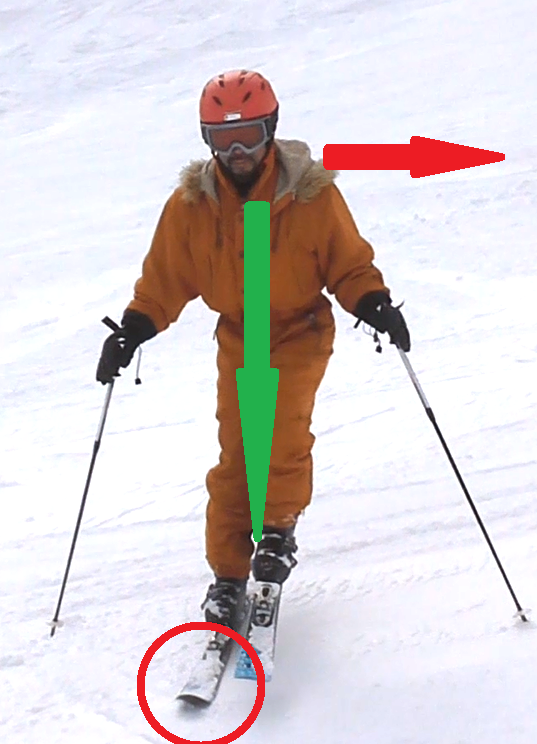
You’ve done well this practice, haven’t you?
Because the edge spontaneously lie down (flatten) if you move CG to the bottom.
And, even if CG move to the top more, you can put your top foot down and you get not to fall down.
There is little change of attitude when you stand on the bottom foot.
Watch video. ↓
“outside foot loading”, “bottom foot loading” are the basic of ski.
You load the weight like that unless you know that.
Lift the bottom foot. Side-slip on the top foot (board).
First, you stand on the slope normally.
You’ll become this attitude spontaneously.
As the direction of the slope change opposite to the above, please switch your point of view=^^=
(from you. left is top. right is bottom. The boards will slip to the right.)
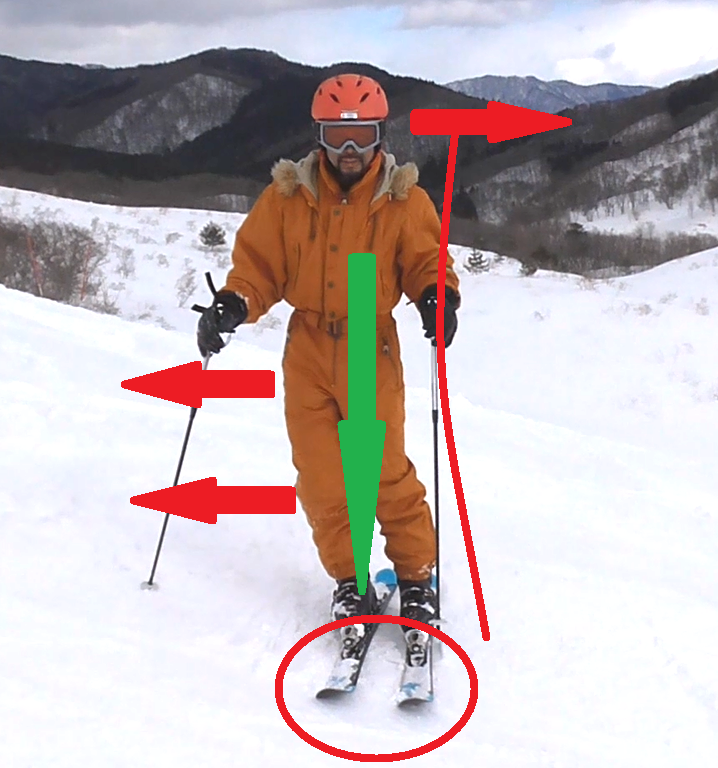
The hips and the knees incline to the “top”.
The head and the upper body slightly incline to the “bottom”.
CG is between the legs.
I load my weight on the top foot more than the bottom seeing this photo.
Or side-slip to the bottom occurs.
You see the edges raise to the top.
• Now, you change the attitude to opposite.
Incline the hips and the knees to the “bottom”.
Incline the head and the upper body incline to the “top”.
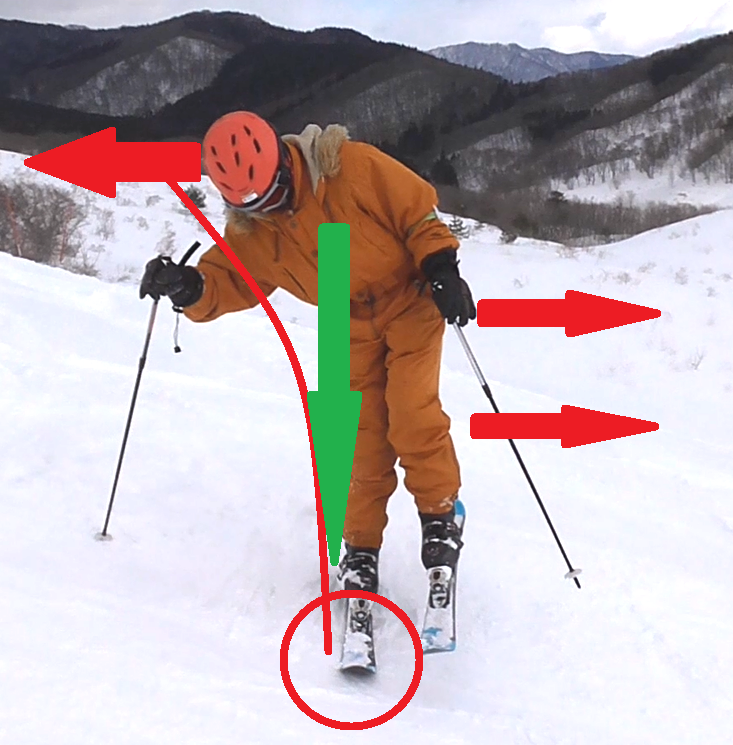
Please make this attitude extremely however it is extraordinary.
You can’t side-slip on the top foot unless you make this attitude.
You would fall down to the top without side-slip if you’ve done halfway.
CG pass over the top foot to the “top”.
You see the edge lies down (flatten) and the board incline to the bottom.
The in-edge (big toe side) is lower than out-edge, you know.
Then the side-slip occurs.
When you need to stop the side-slip, you must incline the head and the upper body to the “top”, and move CG extremely to the “top”.
So the out-edge (little toe side) spontaneously raise up and bite the snow surface to stop the side-slip.
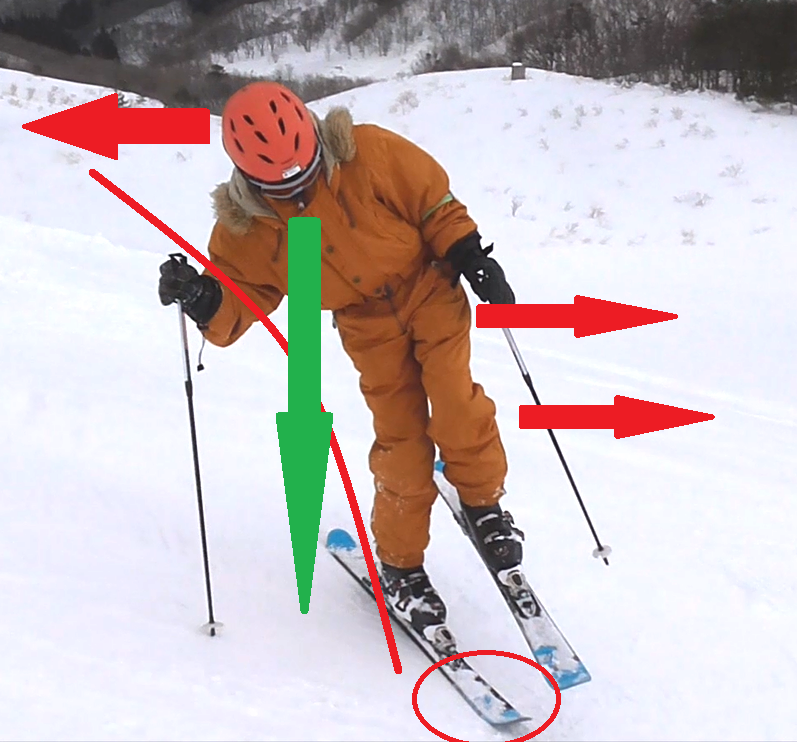
Watch video.↓
I say it’s super difficult. (^^)
It’s no problem if you can’t this at the first time.

Failure cases:Lift the bottom foot. Stand on the top foot (board). Fall down to the “top” as the edge bites the snow surface.
You must fail like this at first.
(from you. left is top. right is bottom.)
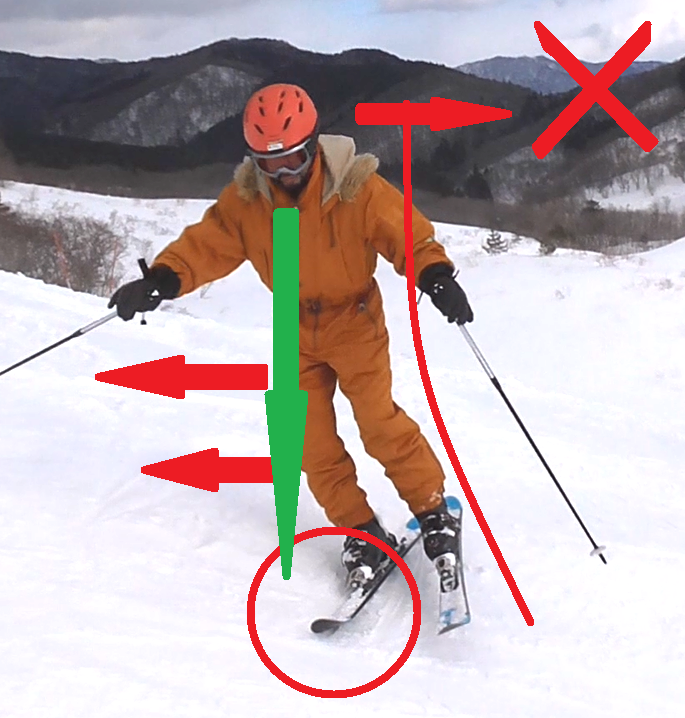
The head and the upper body stand erect, you see.
Human beings always unconsciously tend to stand the head and the upper body opposite to the gravity.
You don’t want to fall topsy-turvy (I mean hit your head first upside-down), do you?
You are programmed to act like that.
The hips and the knees incline to the “top” therefore the board stand (the edge takes effect).
You can’t side-slip the board as the edge bites the snow surface.
CG pass over the top foot to the “top”. And then, you’ll fall down to the “top”.
It can’t be helped that the knees bend to the “top” as you’re just falling down.


You always unconsciously tend to stand the head and the upper body opposite to the gravity. When you stand on the slope, you’ll slightly incline the body to the “top”.
It’s normal and natural “auto execute program” to live, but you must withstand to it to “inside-leg ski” or “Monoski”.
As it’s a extraordinary attitude, you must be aware of it.

Incline the head and the upper body to the “top”.
Watch video.↓ (failure cases)
Traverse (diagonally downwards)
Ski traverse while “Side-slip” you’ve lessoned until now.
I omit the explanation of the “bottom foot” because it’s easy.
The bottom foot
Watch video.↓
(from you. right is top. left is bottom. I’ll ski to the left.)
The top foot (traverse)
It’s the same as “side-slip” you’ve lessoned.
Only you have to do is ski diagonally downwards (forward).
Incline the hips and the knees to the “bottom”.
Incline the head and the upper body to the “top”.
(from you. right is top. left is bottom. The boards will slip to the left.)
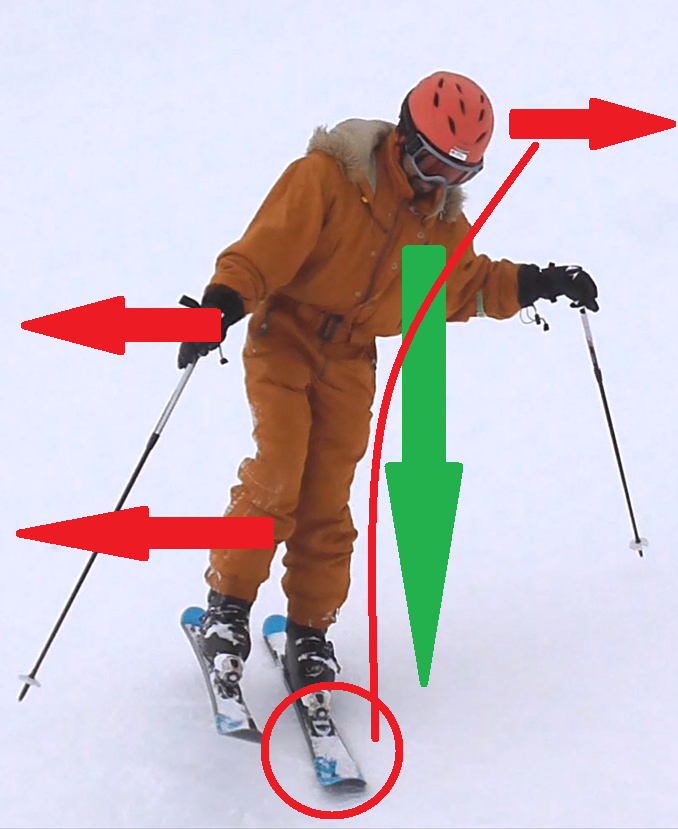
return to the monoski traverse
Watch video.↓
Failure cases:Lift the bottom foot. Stand on the top foot (board). Fall down to the “top” as the edge bites the snow surface.
It’s the same as that you stand on the slope and lift the bottom foot.
Standing the upper body cause the out-edge (little toe side) which face to the “top” bites the snow surface and you’ll fall down to the “top” .
Watch video.↓ (from you. right is top. left is bottom. Failure cases)
I say persistently but,
Incline the hips and the knees to the “bottom”.
Incline the head and the upper body to the “top”.
Turn (dynamics)
Jump turn. How to turn the board


• Compress and Twist
You compress and twist your body to the direction of the turn you want.
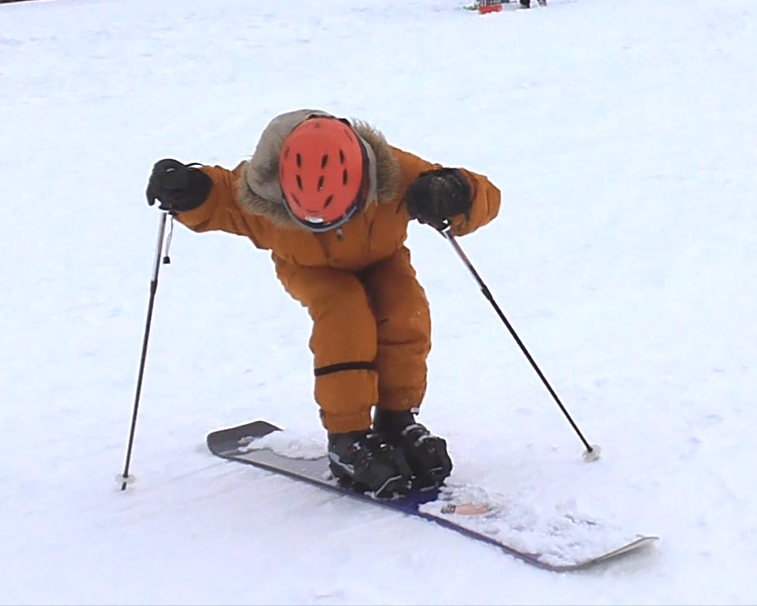
compress and twist
• Reduce the load (extension)
Extend your body as long as you can.
If the board lift off the ground completely, it’ll turn very easily.
Even if it doesn’t lift off the ground, but you reduce the load to the ground and it get parallel to the snow surface,
then the friction of the board and the snow surface reduces and the edges lost the effect, it’ll turn very easily.
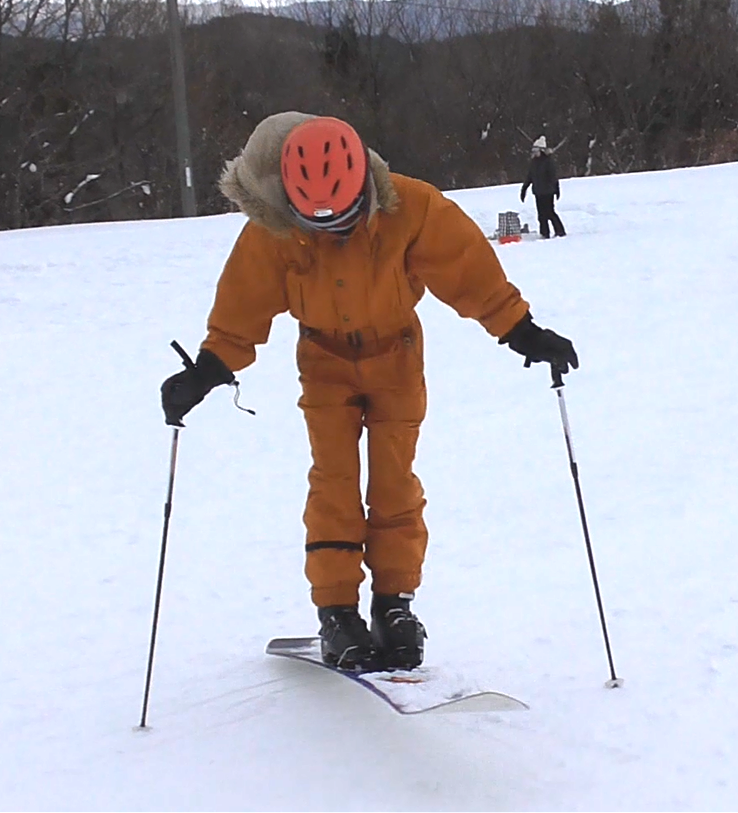
extend (jump)
If the board inclines to the snow surface anyway, the edge bites the snow, and then you can’t turn the board.
When turn, you need to get “the board parallel to the snow surface” and “release the edge”, and turn the board and switch the edge opposite side.
• Turn and Land
The board has turned.
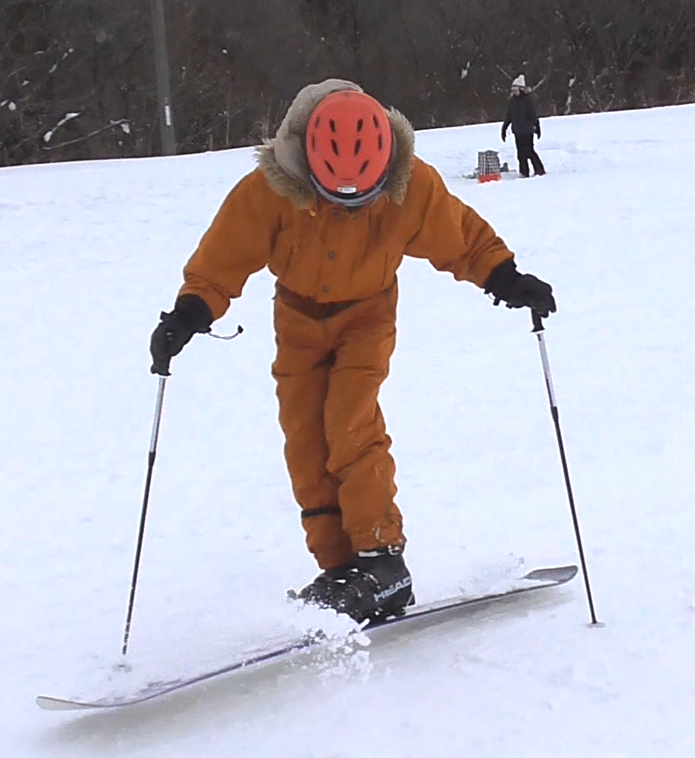
turn and land
“Action and Reaction” law turn the board to the right, the upper body slightly to the left.
When you ski short turn, you apply the “twist” of the upper body to the next (opposite direction) turn.
If the upper body turned same direction with the board, it would be difficult to turn the next (opposite direction).
Watch video.↓
You don’t need to jump, but it’s the same about “dynamics” of turn the board among not to mention Monoski, 2-legged ski, snowboard.
- compress and twist
- Extend your body as long as you can. Make parallel the board and the snow surface. Release the edge. The friction of the board and the snow surface reduces
- By Newton’s third law “action and reaction”, the board turn to the body, the upper body turn to the board.
Recently you can turn to the other direction if your upper body turn with the board because the “carving skis” will very easily turn, but when short turn it would be difficult to turn if your upper body turned with the board.
The upper body face forward (the direction to the bottom of the slope) all the time in the “mogul” you see the Olympic games or World cup games.
Only the hips, the knees and the board turn alternately, but the upper body face forward throughout.
“Twist of the upper body” and “Compression and Extension” are very important to Monoski!
My friend who saw me monoskiing said that
“Wriggling!”
That fits perfectly to Monoski. (^^)
You can’t turn if you stand straight up.
It’s very important to compress and extend with “lithe and flexible” action.
Please do that extremely.
The wasteful actions will come off itself, when you would be able to monoski.
back to “the dynamics to turn the board”
Turn of the one-legged ski
1. Top foot > Bottom foot (out-edge > in-edge) : Switch the edge on one board
Why chose this first?
Because I think it’s the easiest turn among them of the one-legged ski.
First, traverse on the top foot (out-edge).
Watch care that the head and the upper body incline to the top.
And, the hips and the knees incline to the bottom.
If the upper body stands up, you would fall down to the top caused by the out-edge biting the snow surface.
(from you. right is top. left is bottom. The boards will slip to the left below.)

The hips and the knees incline to the bottom.
The head and the upper body incline to the top.
It makes the edge of the top foot lies down (flatten).
Unusual attitude, isn’t it.
But this is the basic attitude of “the top foot ski”.
Now, prepare to turn.

- Compress the whole body and sink down.
- Motion of the CG. Move the head and the upper body to the bottom.
- Twist. Twist the upper body to the direction you want i.e. inside the turn. In brief, face to the “bottom” and consequently you’ll get this attitude.
I wrote 1.2.3 but do all the same time, not in this order.
The upper body twist to the direction you want (right here) and compress down, you see.
The head and the upper body incline to the bottom from the top to turn, and move the CG to the bottom (inside the turn), you know.
The pole is only the trigger.
Don’t stick it into the snow to turn, or you’ll hurt your wrist.
Now, extend your body up to the sky!
And release the twist of the body.
Then friction between the board and the snow surface.

It’s “the power of leg” that extend.
You need “the considerable power of leg” because of only one leg.
As you extend the body and make the board parallel to the snow surface, it will turn itself.
The edge has switched to the other side:”in-edge” of “the outside foot”, you see.
After turned, sink the body down again.
If the knees hold to extend, you could not absorb the shock from the snow surface, and then you would fall down with a little roughness.
It’s very unstable that the body holds to extend.
I mean you should bring yourself into the unstable condition when turn.
To be stable is not to turn going straight.

4. the latter part of turn. Sink down to catch the snow surface again.
When turn, you extend the body to reduce the grip with the snow surface.
After turned, sink down and catch the snow surface firmly using suspension of the knees.

5. Completed to turn!
Watch video.↓
Outside view camera
Inside view camera
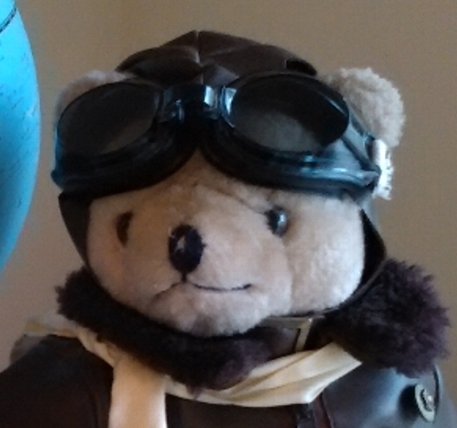
2. Bottom foot > Top foot (in-edge > out-edge) : Switch the edge on one board.
It’s a little difficult this time.
Because you must switch the board from usual bottom foot (in-edge) to unusual top foot (out-edge).
Begin with bottom foot traverse.
Do Watch care that:
The hips and the knees incline to the “top”.
The head and the upper body incline to the “bottom”.
(from you. right is top. left is bottom. The board will slip to the left below.)

And then, Compress and Twist the body to the direction you want to turn (right here).

- Compress the whole body and sink down.
- Shift the CG. Incline the head and the upper body to the bottom.
- Twist the upper body to the direction you want to turn i.e. inside the turn. In brief, face to the “bottom” and consequently you’ll get this attitude.
I wrote 1.2.3 but do all the same time, not in this order.
The hips and the knees incline to the “top”, and
The head and the upper body incline to the “bottom”, you know.
Act extremely like this to turn,
or you’ll fall down the edge biting the snow surface.
This is very important!
“Twist of the upper body” and “Compression and Extension”
Extend and make the board parallel to the snow surface, it’ll turn itself.
Though the edge is opposite to “top foot > bottom foot turn” above, but it’s same that:
reduce the load and friction between the board and the snow surface, and flatten the board cause to turn the board easily.

Switch the edge from inside to outside.
The bottom foot changes to the top foot.

4. The edge switch from inside to outside. The bottom foot changes to the top foot.
Remind when on the top foot (out-edge):
Yes!
The hips and the knees incline to the “outside of the turn”.
The head and the upper body incline to the “inside of the turn”.
If you stand the upper body straight up, the out-edge (inside the turn) bites the snow surface and you’ll fall down to the inside of turn.

It’s a extraordinary attitude that the head incline to inside and the hips incline to outside, but this is the basic attitude of “inside-leg ski”.
Please master it!
I say again insistently.
If the upper body stand up, the out-edge bites the snow and fall you down to inside of the turn.

6. Turn has completed!
The point of inside-leg ski:
Hips and Knees “Outside”
Head and Upper Body “Inside”
Watch video.↓
Outside view camera
Inside view camera
3. Top foot > Top foot (out-edge > out-edge) : Switch the board
Now, here we are the end of lessons of “one-legged ski”.
To be frank, it’s very difficult!
Even though “top foot ski” is unusual, furthermore you need to switch the board to inside the turn just at the turn. (^^)
That inside-foot will become the next top-foot.
I mean, out-edge > out-edge!
So as not to let the edge bite the snow, you need hips and knees incline to the bottom throughout.
The head and the upper body must incline to the top.
When turn, hips and knees must incline to outside of turn throughout.
The head and the upper body must incline to inside of turn throughout.
The direction of body shift 180 degree at the turn, the head and the upper body also switch to the other directions.
Switch your thought, please.
It’s ordinary you can’t do this at first.
Don’t worry about it.
If you can do this easily at first, you don’t need this textbook. =^^=
It’s important that you don’t let the edge bite the snow especially out-edge.
To lay down or flatten the board and release the edge, you must do is:
Incline the hips and the knees to the “bottom”.
Incline the head and the upper body to the “top”.
when turn
Incline the hips and the knees to the “outside of the turn”.
Incline the head and the upper body to the “inside of the turn”.
Let’s begin!
First, traverse on the top foot.
This is the same as the lesson of “top foot > bottom foot” at first.
(from you. right is top. left is bottom. The boards will slip to the left below.)

1. Traverse. The hips and the knees incline to the “bottom”. The head and the upper body incline to the “top”.
Prepare to turn.

2. Prepare to turn. Sink down. Shift the CG to the bottom. Twist the upper body to the direction of turn.
- Compress the whole body and sink down.
- Shift the CG. Incline the head and the upper body to the bottom.
- Twist the upper body to the direction you want to turn i.e. inside the turn. In brief, face to the “bottom” and consequently you’ll get this attitude.
I wrote 1.2.3 but do all the same time, not in this order.
As you begin with traverse, you face to the bottom just before the turn, but when short turn, “the head and the upper body face to the bottom throughout”.
To turn is only below the hips.
Only below the hips and the board turn right and left, while the head and the upper body face to the bottom throughout.
Imagine the scene of “Mogul ski”.
It’s a good idea to watch Mogul ski at YouTube.
• moment of turn
Extend into the sky as you can. (Reduce the load.)

3. Extension. Reduce the load. Release of twist. Switch the edge.
Extension and reduction the load let the board turn freely.
Release of twist of the upper body turn the board itself.
Reduce the load, at the same time make the board parallel to the snow surface, then the edge will be released and the board will turn easily.
Even if you reduce the load, the board can’t turn unless the edge hold to bite the snow.
the edge has already switched from out-edge to in-edge in this photo.
Until now, it’s just the same action as the first lesson “top foot > bottom foot”.
So about the attitude.
From now on, it becomes difficult.
• Switch the board (Ride on the other board)
Extend and land with inside foot (opposite to the beginning)
From now on, it’s the same attitude of “bottom foot > top foot” lessoned above.

4. Switch on the inside-leg. Sink down to catch the snow.
Just have switched from outside-leg to inside-leg, though it might be little difficult to see.
From left to right, here.
It’s the most important point!
Switch outside-leg to inside-leg (right leg here) and sink down to catch the snow, very immediately switch to “incline hips and knees to the bottom, head and the upper body to the top”.
Most of you stand the upper body straight up, causing out-edge of the inside-leg (to be top foot after : right here) to bite the snow, and then fall you down to inside the turn.

5. Hips and knees to outside, head and the upper body to inside. The attitude of inside-leg ski.
It’s an extraordinary attitude that head and the upper body incline to inside.

6. Turn has completed! Hips and knees to the bottom. Head and the upper body to the top.
I say again and again, however please forget the normal ski =^^=
This is the basic attitude of “inside-leg ski (out-edge ski)”.
Watch video.↓
Outside view camera




Katu-karē (Curry rice with fried pork cutlet) ¥800
It’s a “Katu-karē” one of the dishes in this restaurant at the lakeside in the “Ombara ski area” where Ojisan often go to Monoski.
Foods of ski area are often said that “expensive, little, undelicious”, but “reasonable, enough, delicious!” here.
Katu-karē
Japanese most popular dish.
It’s a curry rice mounted by fried pork cutlet.
“Katu” is from “cutlet”, but only fried pork in Japan.
“karē” is from “curry” hot spiced soup originally in India.
I’ve never met the one who didn’t like this dish.
Why not try it, when you visit to here in Japan?
Monoski
I omit the same attitude and theory as “one-legged ski”.
The one who visit here first without preparation had better practice “both-legged ski” first after watching videos!
Return or jump to “both-legged ski” above
Side-slip (on the slope)
It’s the same as both-legged ski.
Two boards are only bound to one board.
But even if you break the balance, you can’t step to recover, therefore you’ll feel uncomfortable.
As both of your legs ride on “one” board with Monoski, you need not to shift the body or make extraordinary attitude.
It would be a straight attitude such as “top foot ski” plus “bottom foot ski” and then are divided by two.
At first, extremely
Incline hips and knees to the “bottom”.
Incline head and the upper body to the “top”.
Such as Side-slip of “top foot ski”.
Or it will not begin to slip no matter how much time passes, because the edge stands up and bite the snow (I mean take effect).
Or you’ll fall down to the top, as the top edge bites the snow.
See “Side-slip of top foot” please.
(from you. right is top. left is bottom. The boards will slip to the left.)
You’ve managed to “Side-slip”, haven’t you?
First, I think the board doesn’t move at all.
Because the edge stands up.
If you’ve practiced “Side-slips” of both-legged and one-legged ski, you can feel the board slips by “inclining hips and knees to the bottom, head and the upper body to the top”, can’t you?
Traverse
From now on, you must feel the Monoski difficult.
It’s almost same as attitude of “top foot ski” of one-legged ski.
Spell is “Hips and Knees to the bottom. Head and the upper body to the top”.
(from you. right is top. left is bottom. The boards will slip to the left below.)

Hips and knees incline to the bottom,
head and the upper body unnaturally incline to the top, you see.
The board inclines to the bottom, therefore it becomes near parallel to the snow surface.
The edge lies down (flatten), therefore the board becomes easily to slip to the bottom.
It’s unnatural but basic attitude=^^=
I overact intensionally at the photo above, but I usually stand almost straight up like the photo below.
However, “Overact” at first.

The edge stand up more than the photo above, but angle between the board and the snow surface is shallow.
Watch video.↓
(from you. right is top. left is bottom. The boards will slip to the left below.)
Failure cases (You’ll get into this situation at first.)
If head and the upper body stand straight up, the top edge will bite the snow and fall you down to the top.
Compare the attitude above.
Turn
Now, here we are.
The essence of Monoski : Turn.
If you could have done this, you could have done “Monoski”.
• Entry
First, enter traversing practiced above.

1. traverse
“Hips and knees to the bottom.
Head and the upper body to the top.”
Watch the edge lies down (flatten)!
• Preparation of turn

2. Compress. Shift the CG. Twist.
- Compress the whole body, and sink down.
- Shift the CG. Incline the head and the upper body to the bottom.
- Twist the upper body to the direction you want to turn i.e. inside the turn. In brief, face to the “bottom” and consequently you’ll get this attitude.
I wrote 1.2.3 but do all the same time, not in this order.
Hips and knees are bending so very much.
Bend about breast touches knees.
You need to do like this to turn Monoski.
Watch the edge already inclines to the bottom, and becomes parallel to the snow (slope)!
• Reduce the load. Extension. Release the twist. → The board turns.

3. Reduce the load. Extend about to jump.
Extend about to jump.
If the board becomes parallel to the snow surface and doesn’t bite the snow, twist will be released and the board will turn itself very easily.
• Switch of the edge

4. Switch of the edge
After reduced the load and turned the board, the edge has switched to the inside of turn.
You can see bottom surface of the board.
It’s in-edge of outside-foot about two-legged normal ski, but out-edge of inside-foot about Monoski.
Complicated, don’t you?
• the latter part of turn

5. the latter part of turn. Head and the upper body face to the “bottom”.
Different from two-legged normal ski, knees incline to the outside of turn, and the board is flattened so that the edge won’t bite the snow.
Of course, if you would run faster, the board would become to stand up and the edge take effect.
Don’t worry about it, you will naturally become like “so” without consciousness. =^^=
It’s important that already
“Head (face) and the upper body (breast) face to the bottom“
prepared to the next turn.
In many textbooks or videos of ski, we see the word “face outside of turn”.
But, it misleads us.
Ojisan (it’s me!) also have troubled by this word to practice ski (^_^;)
Forget it!
You must not face outside of turn.
“Always face to the bottom”
↓
Consequently “you unintentionally face outside of turn at times”
Never look outside of turn.
Always look the bottom.
Teachers and trainers often use difficult, complicated, or misleading “jargons”.
They misunderstand that trainees respect them who use “jargons”.
In addition, they misunderstand they’ve become quite a good teacher or trainer to use “jargons”.
Ojisan intend to use simple words and write sentences easy to understand, how’s that? (^_^;)
Oops! The story was got off!
Let’s return to Monoski!
To turn you must precedingly “twist” or “hold to face” the upper body to the direction you’ll turn.
Don’t ease your mind off when turned, keep mind to hold head and the upper body to “face to the bottom“.
So already “head and the upper body face to the direction to turn next”, even if you don’t twist before turn next.
See photo I compressed at entry of turn again.
“Face inside of turn”, you see =^^=
See photo compressing prepared for turn.
Don’t face to outside, but face to the “bottom”.
Otherwise, when not to turn immediately the next such as “long turn” (large radius) or followed by traverse or stop, it’s no problem that the upper body turn together with the board.
Seeing the photo below, soon after having caught the snow, I’m already compressing the body to turn the next and head and the upper body are facing to the bottom.

6. Compress and catch the snow. Preparation for the next turn.
• Attitude of traverse at entry
Usually almost straight up.

1-1. Traverse. Usually almost straight up.
However, at first, be through with “Hips and knees to the bottom. Head and the upper body to the top”.
Wasteful action will remove itself if you would be able to Monoski.
• Case of a turn followed by the next turn
About beginning with traverse, I explained above.

1-2. Case of a turn followed by the next turn
However, at the case of a short turn soon followed by the next turn, the board face to the “top”, but head and the upper body (face and breast) face to the “bottom” like this photo, you see.
It’s different from the attitude of traverse 1.
As already head and the upper body have faced to the bottom i.e. “Twisted”, only you must do is compression and shift CG to the bottom before next turn.
To turn continuously.
Have you turned well even once?
Congratulations!
You think next that “I turned and then stopped, couldn’t turn the next turn to opposite direction…”, don’t you?
It’s because that head and the upper body have turned together with the board.
That’s good at first. No problem.
If you’ve become to be able to turn easily, to short-turn continuously, you must do is
Always face head and the upper body to the bottom.
Sounds difficult but I say it more simply like that
Always look at the bottom of the slope.
Look at the rest house or ski lift station underneath throughout.
Watch video.↓
Outside view camera
It’s the same as turn of one-legged ski.
But only you can’t lift your leg or step to side because your legs are fixed on one board.
- Compress the whole body, and sink down.
- Shift the CG. Incline the head and the upper body to the bottom.
- Twist the upper body to the direction you want to turn i.e. inside the turn. In brief, face to the “bottom” and consequently you’ll get this attitude.
It’s the same as explained at one-legged ski.
Do all (1.2.3) the same time, not in this order.
If you would watch video, you’ll get to know I’m squatting about breast touch knees.
At first, do extremely like this.
Usually even you felt ashamed to do exercise or dance and so on extremely yourself, but you did not move at all watching videos later or someone looking you from the side.
Attitude, CG (Center of gravity)
Poles
I shorten poles as I squat extremely to Monoski.
“Ojisan” set poles at 100cm.
I say “set” because I use “telescopic” i.e. variable of length poles.
If you use long poles, that cause you stand straight up like a pole.
Therefore use shorter poles.
Attitude
You can turn easier to shift CG slightly to rearward.
Don’t bend backward or let your hip rearward.
Like you sit down on your heels.
Furthermore CG shift behind your heels on mogul or powder snow.
Then already your weight don’t ride on your toes, but you lift up the front of board by your toes picking bindings up.
The nose of board lifts up and lands with a pitter-patter.
After such a skiing, you’ll get pain at your shins the next day. =^^=
It changes by character of the board : size of side-cut, over-all length, width, flexibility or by your physique, the way to ski, condition of the snow, therefore please find your most “comfortable” position.
Inside view camera
Dynamics of turn the board
As those are “Compression”, “Twist”, “Extension to release of the twist”, please review “Jump turn” and practice again.
You don’t need to “jump” actually.
If you extend to release the twist and make the board parallel to the snow and release the edge, the board will turn easily.
The board can’t turn, if the edge raise up and stay bitten the snow even you’ll twist or extend.
How to tumble


Maybe you think it’s not important, but you get to know if you put Monoski on.
“Why can’t I move at all like this!?”, you’ll think.
Also snowboard fixes both legs, but you stand legs apart.
Differently from snowboard, you’ll tumble only sideways on Monoski.
Then you won’t hit back of the head, but you’ll hit side of the head and shoulders hard unless you know how to tumble. You’ll hurt arms if you hit them.
Try it, and you see that you’ll unconsciously try to step sideways the direction you’re falling down though your both of legs are fixed on the board.
You must become confused as you can’t step sideways.
Be sure to put the helmet on, please.
It’s really dangerous!
Say, if the one of 160cm-tall fall down standing straight up to the ground, his head falls from 160cm-height and hits the ground.
If he squats and tumble to the ground, his head falls down from about 80cm-height, and then impact reduces about half.
Furthermore, if he squats and tumble, actually his hips land first and also his body becomes to rounded, then he escape from impact of the ground.
And interesting to say, when you feel to “tumble!” or “be in danger!” and squat, then I don’t know why but you won’t tumble and recover the balance in most cases.
Furthermore, if you squat, you can touch the ground softly.
Therefore,
Tumble! In Danger! > Squat! Round!
Remind like a spell.
When you get up, you need so much power to raise 160cm-tall pole if you hold to extend your body still straight.
Supposedly you can’t get up.
Draw the board to your body as you can, and bring your head near the board as you can, then you can ride your body on the board easily.
And then, get up.
You’ll get to know well about that if you see videos.
How to get up
1. Turn the board.
“Why say such a thing?”
You may feel so, but you’ll get to know if you put Monoski on.
It’s difficult to get up even on the horizontal place, if you fell down with your head lower side of the slope (the bottom) i.e. your head is lower than your foot, it’s impossible to get up.
First, turn the board to the bottom : the lowest place.
I struggled a little in this video, because I took the video on the almost horizontal place. (^_^;)
Actually the more steep slope, the more easily you can get up because your head is placed higher position than shallow slope turning the board to the bottom.
I get up after drawing the board to my body, as you see.
It feels like I sit down on the board, putting my hip on it.
2. Tumble
“Tumbling” is easier.
You can move the board to the bottom with less power than to turn it.
The more steep slope, the more easily tumble, too.
I struggled because I took the video on the almost horizontal place. (^_^;)
Turn the board if it’s about 90 degrees to turn.
If head is placed on the bottom, and the board is placed on the top, “Tumble” is easier.
If you can’t move the board at all, then release it. =^^=
You had better practice to release bindings in advance.
You might not be able to move at all when fell down in the deep snow as the board stuck into the snow.
Release it!
Scene of Monoski
1. chasing
2. pass by

Well, let’s make your debut of “Monoski” next winter!
Monoski goods, gear
Board & Bindings
Such an appearance.
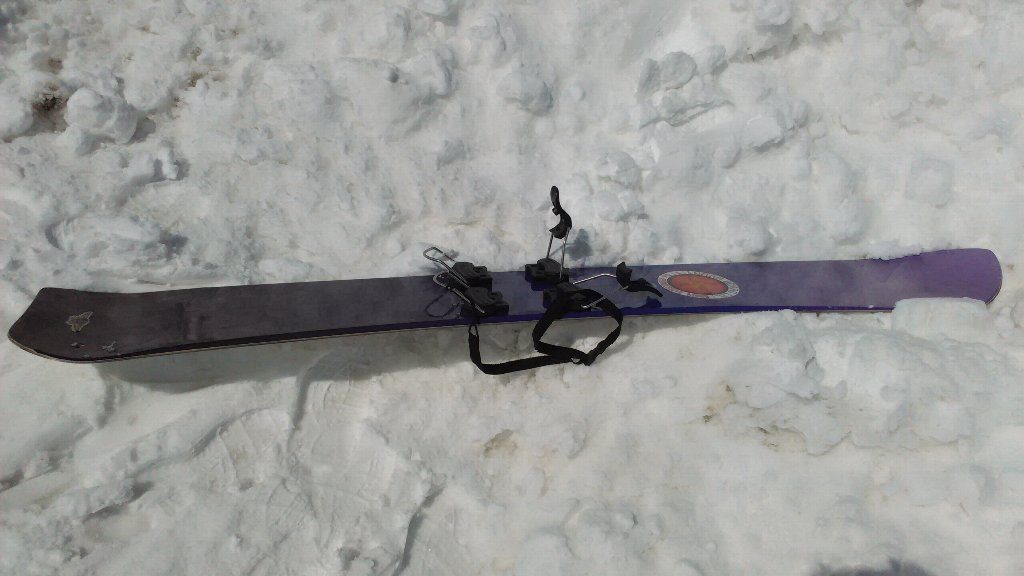
Bindings
It is very simple like this also used for mini-ski .
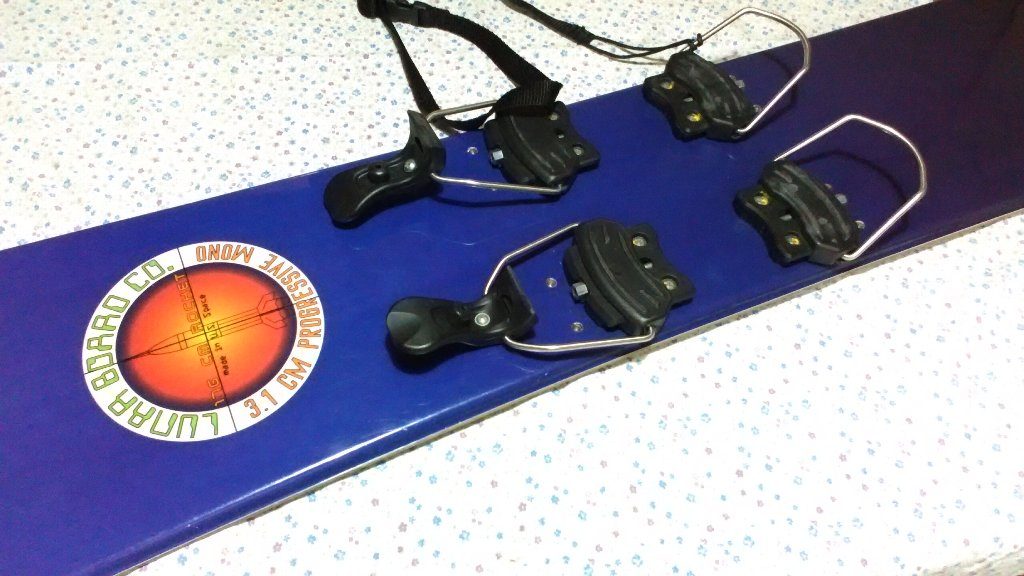
Feel like a little unreliable, but as both legs are fixed to one board about Monoski, strong stress never load to one leg.
Therefore you don’t need to tighten bindings so much.
Furthermore you don’t need tight boots and tighten them, therefore it’s more comfortable than 2-legged ski : normal ski.
To refer to 2-legged ski, whole weight sometimes load on one leg (or one board), and boards are tossed about by the snow to right and left, then strong stress load on bindings, as a result, it cause bindings to release.
“Ojisan” have experianced that binding have come off the board which I bought at a bargain in a sport shop when I was skiing on moguls.
Not released, but broke. Bolts came off the board!
“Ojisan” have used this Monoski over 20 years, it’s still in good condition.
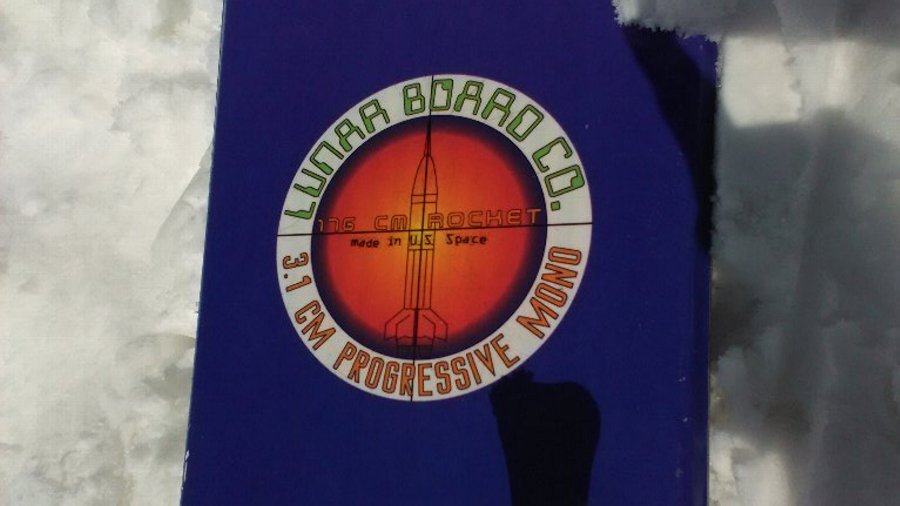
Lunar Board co. (I don’t know this company still exists.)
176cm Rocket
Made in U.S. Space
3.1cm progressive MONO
There are many ski shop in Kanda, Tokyo, Japan.
I walked around and entered one after another, but I never found Monoski.
To think now, I had better go to shops after telephoned. (^^)
I thought I could take Monoski just by going.
There was not ADSL, but dial up.
I looked for Monoski and bought through agent in Japan.
Certainly it cost about 70,000 yen with bindings, shipping fee and so on.
There isn’t Amazon. com like today.
I didn’t know how it was and whether or not it would be actually delivered, that was a bet.
As a result, I’ve got a very good one.
Recently I searched Monoski, then I looked the one perfectly same as mine put on the market called “Rare!”.
Is it about fossil? (^_^;)
Umm…I had better buy a new one?
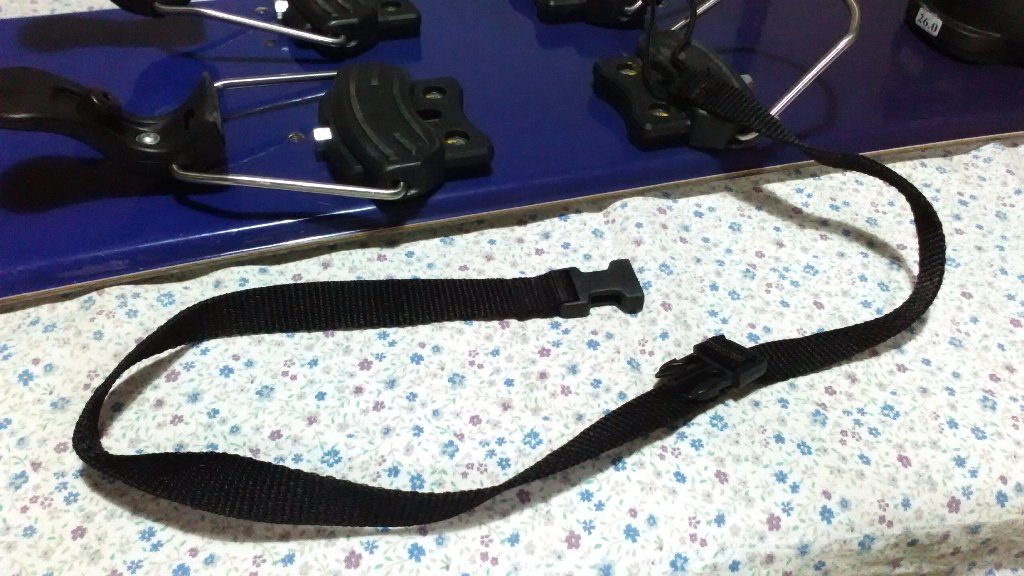
Be sure to put “leash cord” on.
Though I never experienced that both of bindings release at the same time.
Sometimes it occurs that one binding releases because snow stuck on the bottom of boot. (^_^;)
Boots
Usual boots for usual ski.
You don’t need to put boots for rigid alpine skiing on as written above.
It’s OK that is soft and hold totally your feet!
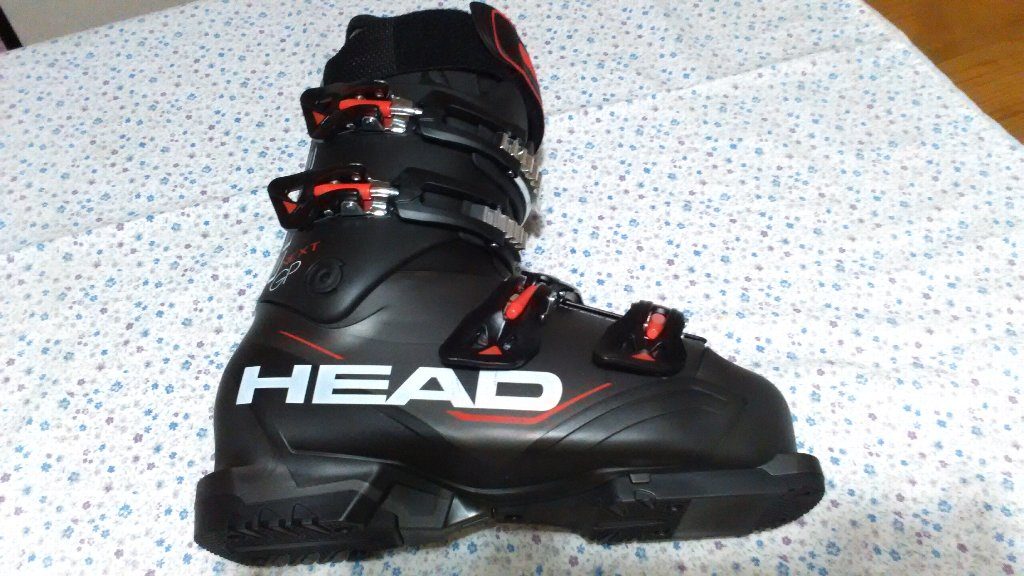
It feels like this you attach a boot to the board.
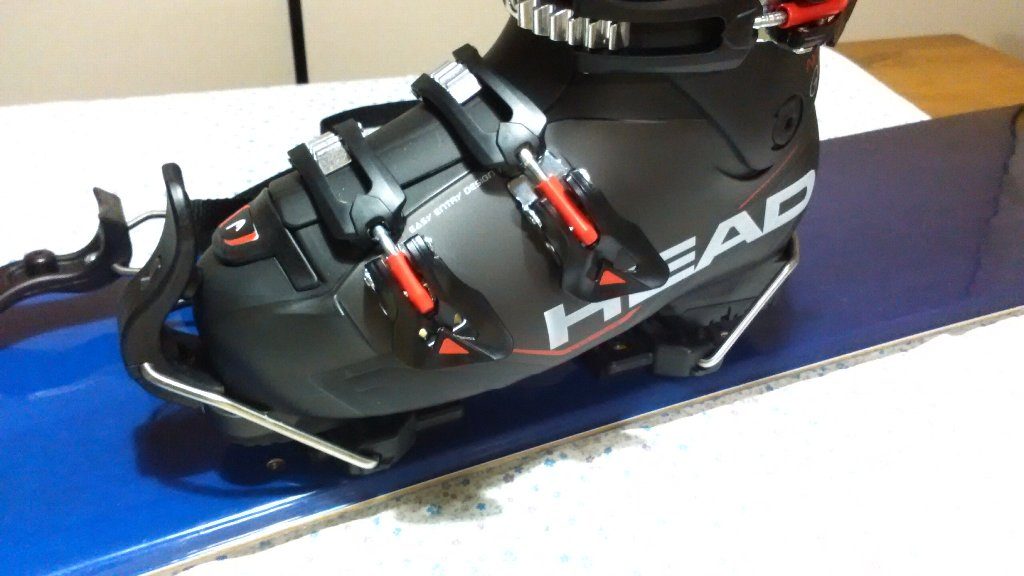
HEAD next edge GP
23,000yen was discounted to 18,000yen.
Poles
It’s “telescopic” pole that “Ojisan” have begun to use for Monoski.
That will extend and contract.
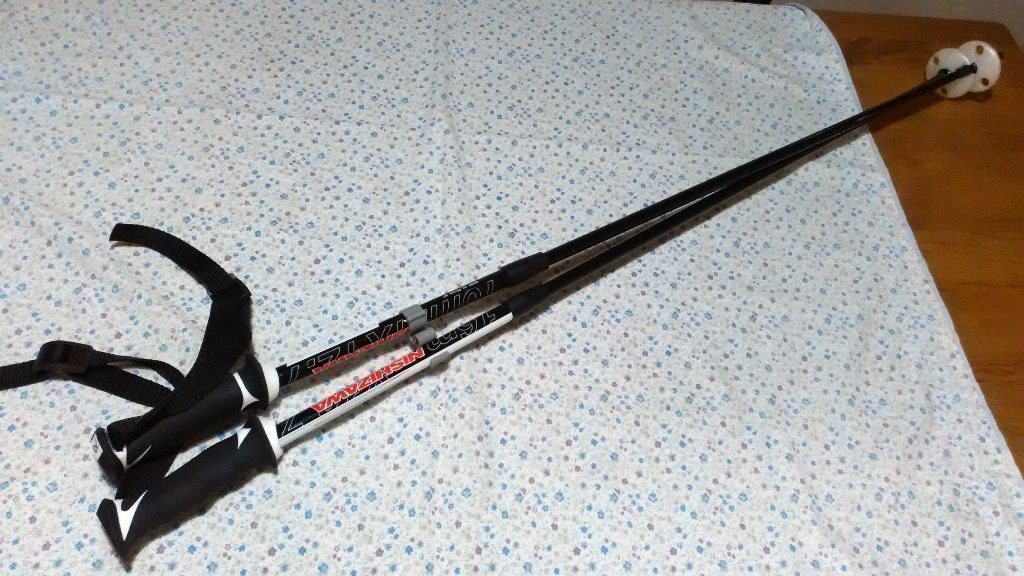
At first, I used the ones for 2-legged ski, but I felt it was little difficult to Monoski.
I’ve got to know that I lower hips even more squat in extreme case, then I thought change shorter ones.
But it’s the problem if poles would be too short after I bought them!
Then I’ve got to know “telescopic” poles which is variable length.
“Telescope” is a device to see far like stars.
The mechanism is that double cylinders slide and change length.
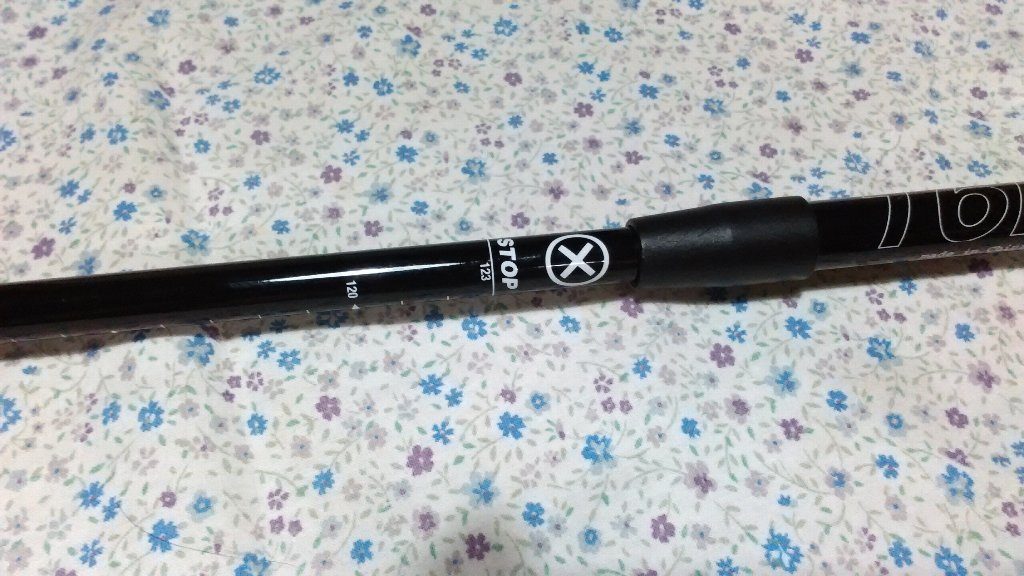
As you turn it counter-clockwise, it loosen, then you adjust the length you like, thereafter you turn it clockwise to fix.
In brief, it’s the same as “tension rod”. (^^)
“STOP” and “×” of photo above says that “If you would extend me over this line, I might come off!”
This pole can extend up to a maximum of 123cm.
I experimented various length, I Monoski with shortest 100cm in conclusion now.
If poles are short, that make you squat consequently.
That’s good!
Don’t bend only hips and incline upper body forward we say “Heppiri-goshi” in Japanese which means “break wind style” (^^) or “prone posture”, but compress whole body especially knees.
If knees extend straight, you can’t turn and lose balance.
Goggle (not google) (^^)
As “Ojisan” don’t mind appearances or brand, I’ve used cheap goggle bought at sport shop.
With Monoski I bend and stretch throughout skiing harder than 2-legged ski.
That is repetition of compression and jump.
As I sweat, the goggle get fogged soon.
Anti-fog agents never take effect.
If you can’t see outside, how you can ski, can you?
As a last resort, I remove goggle, then I can’t see surroundings after all especially when it snows .
Therefore I decided to buy a “Goggle with Fan”. That is a ventilator.
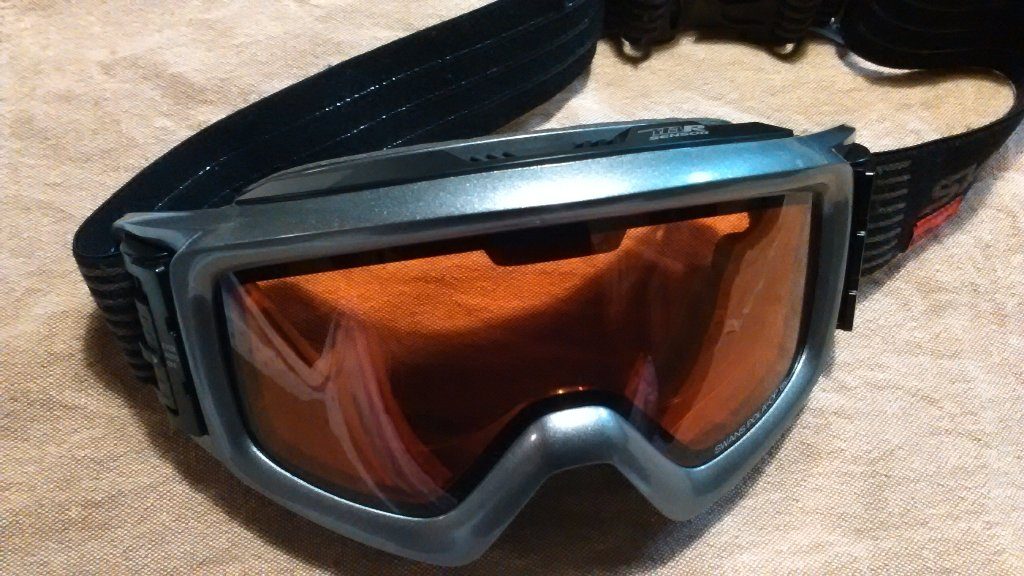
This is a fan. Just same as extractor fan of kitchen.
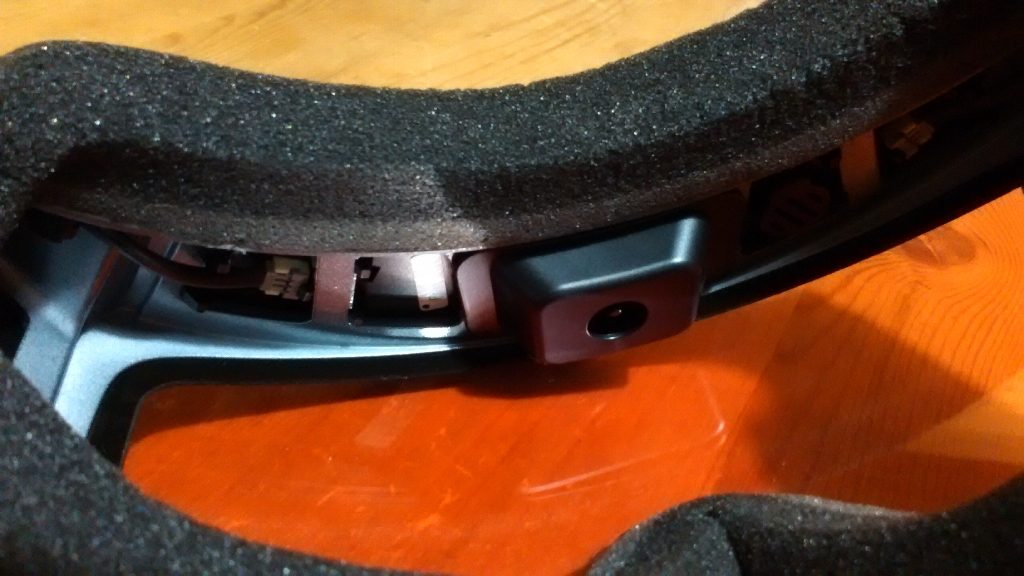
Switch
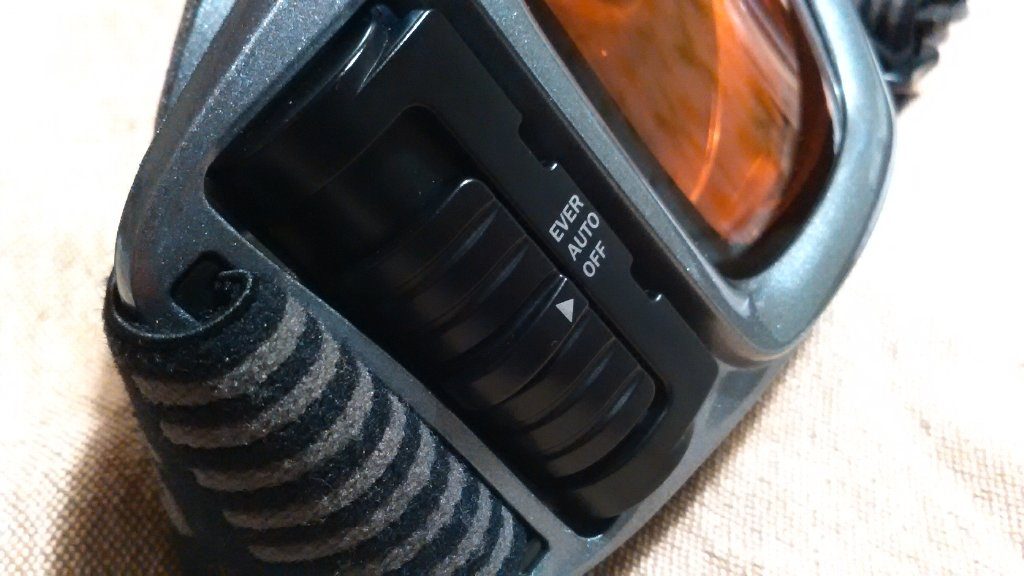
EVER : it runs ever.
AUTO : it runs only when humidity in the goggle rises up with sensor of humidity.
And welcome AAA (R03, LR03) battery!
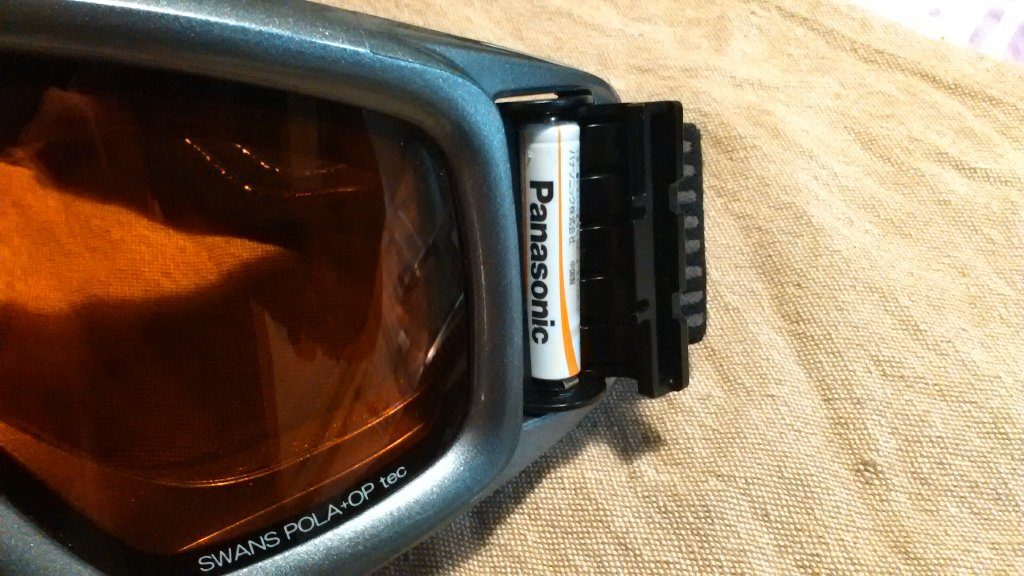
I’m really troubled by dedicated battery for smartphone or button cells which are hard to obtain and expensive.
I wonder what on earth built-in battery of smartphone is made?
We must buy another whole body when battery has passed away.
What? There is no one who use to that extent?
Anyway you have no worries for battery out if you carry one reserve.
I never experienced battery out.
List price is 22,000 yen.
I bought it for about 13,000 yen at internet shop.
It’s worth to have!
Helmet
And don’t forget helmet!
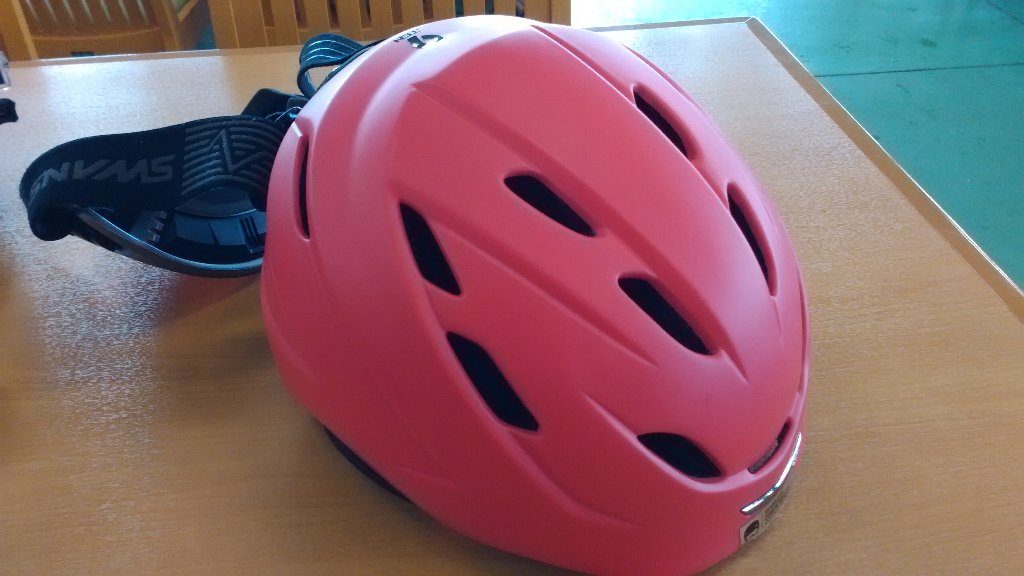
Be sure to put it on, don’t say bothersome or uncool!
It’s really dangerous if you would fall down.
I say again.
“You are tied at both of legs.” =^^=
Maker:GIRO
List price 18,000 yen was discounted to about 15,000 yen.
driver
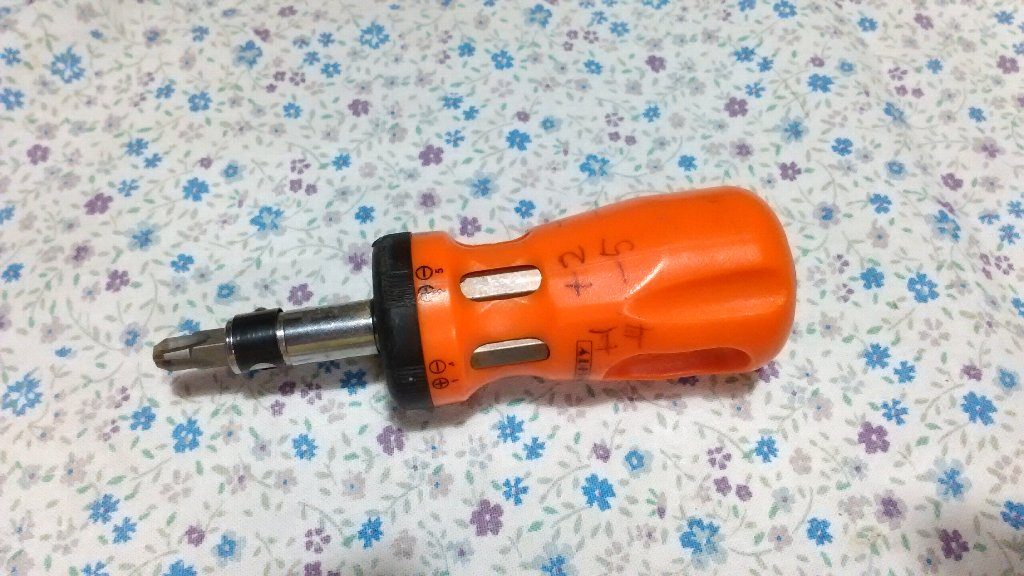
This driver has many kinds of bits inside.
Long driver is dangerous! Don’t carry the long one.
It might stick you falling down.

Difference of Monoski from normal ski
Weak points
• legs tied
At first, your both of legs are tied. It’s more serious than any other.
You can’t step when you lose balance about to fall down.
Consequently you might have fallen down.
• larger dimension, heavier, high inertia, larger friction
Second, the board is larger than normal ski, that is heavier than normal ski.
It is made larger especially sideways as a pair of boots not to go out of the board.
It’s wider than 2-legged normal skis.
Consequently it’s heavier than normal ski.
As there is side-cut, nose and tail are furthermore wider.
In other words, width of nose and tail are determined by that of place where two boots ride on side by side not for side-cut. (^_^;)
Originally Monoski is the board difficult to turn, furthermore it need power or twist to turn as it is heavy i.e. has high inertia.
Large area have large friction causing less speed than 2-legged ski.
• shorter edge length, less effect
Monoski has only one edge, which take less effect when turn or standing slope.
2-legged ski have two edges.
Say, ski length is 170cm, 170cm×2=340cm-long edges take effect to the snow about 2-legged ski.
Still 170cm about Monoski.
Therefore Monoski dislikes ice burn =^^=
Same as snow board.
Advantages
• tied legs never open
“Your both of legs never open absolutely!” because they are fixed to one board. (^^)
Whatever, whenever your legs never open.
Your legs never open whatever mogul you go even you tumbled upside-down. =^^=
Good skier skis beautifully gathering both of legs.
The ones who don’t know Monoski look upon Monoskier as good skier gathering both of legs.
You could do it from first day you began to Monoski.
Except for can or can’t.
• never sink
You never sink into the snow even new-fallen deep snow because of wide board.
If you Monoski on the powder snow, you feel like on the back of dolphin.
I never have ridden on dolphin, but I guess like that. (^_^;)
Feel like the board are swimming under feet.
Differences
• all or nothing, 1 or 0. No midway.
You can 2-legged ski even for the first time.
You can stand on the slope, and can slide down opening legs for the first time from your birth.
While you can’t stand on the slope putting Monoski on except for horizontal area.
It’s same as snowboard.
You are advancing step by step beginner to expert about 2-legged ski, while there is no midway between beginner and expert about Monoski, but only “can” or “can’t”.
There is no Bogen or Stemmbogen, but parallel from beginner. =^^=
Normal ski is analogue (continuous), while Monoski is digital (dis-continuous).
I mean “0” or “1”. There is no 0.26 or 0.74 and so on.
Attractiveness of Monoski?
It’s integrated feeling man and board before everything.
Cheating never take effect.
To lose balance cause instantly to tumble.
“Ojisan” have never been able to gather both of legs on 2-legged ski even how many times I practiced and how many years has passed by.
So is today. =^^=
Because I can cheat.
If I lose balance, I can step to recover the balance.
Then I can ski down any slope of ski area, but I never have improved myself in ski anymore.
Both of legs gather themselves unless you try to do that with Monoski.
If you balance on Monoski, you can feel integrated with the board and have conversation with the snow.
You need more severe balance and feedback than 2-legged ski, while you can enjoy communication with the snow.
If you ignore the snow and have your own way, you’ll tumble at once.
You feel relation of board and snow very well.
What a feeling of satisfaction when you’ve got to be able to control Monoski!
In addition, you draw attention from others. =^^=
Disappointingly I almost always ignore in Japan. (T_T)
They look my board but make believe to see nothing. (^^)
I’ve rarely talked about it in west area in Japan.
People in west area are more friendly than east.
I like them.
But I don’t think eastern people are cool.
They are reserved.
I’ve been to Whistler, Canada, where I talked very often!
I want to say Japanese are not cool but reserved and shy.
Please don’t think us Japanese dislike you foreigners.
The most reason is that we mostly can’t speak and hear English or other foreign languages.
I’ve been to U.S.A. and Europe, where they have very often run away from me. (^^)
Maybe they thought they couldn’t understand my language to see my Asian face.
Q&A
Where can I get monoski?
You live in convenient days.
You can get it on internet sites.
But wait!
You had better buy monoski after you’ve done well one-legged ski, especially out-edge skiing.
If you want to try monoski reading this page, but there is no one riding monoski and teaching you monoski.
Maybe you can’t monoski at once or stand on the ski slope, it would go to your closet or garage.
Can I rent Monoski?
Yes, you can though it’s a few where you can rent it.
Search with internet ski area near you.
Then phone direct to there, and go there.
If you’d felt like to be able to Monoski, thereafter you might get it.
When you ride on lift.
Only one foot bound to the board, keep released the other to step at any time.
Put leash cord on to leg not to release.
When you would reached terminal station, only you should do is that you hold poles with each hands and step on the board and then stand straight up, if so lift chair will push you forward.
You can easily get off rowing with poles a little.
Do I need special equipments?
As shown above, that’s all the same as normal ski.
How long the board length?
It’s often to say that stature plus 10cm is good about ski .
It had better be a little shorter about Monoski.
The more long and heavy , the more has large “inertia“.
Inertia is character of the body that it stayed intend to hold staying, it running intend to hold running.
Long and heavy : stable. difficult to move or turn. You have difficulty to turn.
Short and light : unstable. easy to move or turn. You can easily turn.
The board of Monoski is wider and heavier than 2-legged skis.
It’s difficult to move tied both of legs, furthermore you struggle to turn the board which is long and heavy.
Mogul ski is also short which turn shortly and rapidly like Monoski.
As “Ojisan” didn’t know that, I have got 176cm-Monoski even I’m 165cm tall, then I’ve seen I need extreme action of whole body and energy to turn.
As now I’ve got used to Monoski, I need less power and less action, but if you’ll get from now on, you had better choose the one same as your stature or a little shorter.
Snowboard also use shorter one than stature, you know.
How many Monoskiers?
I don’t have precise data.
It’s about 50 years from having got started ski at primary school.
I’ve ever seen Monoski without me only about three or four times except for meeting.
I’ve been to Whistler, where I’ve never seen Monoski.
But they knew Monoski or asked me frankly what that was!
• Monoski meeting
Once I’ve participated in Monoski meeting which was had Monoski association in Japan.
There were about ten persons from whole Japan.
Of course, participants were ten, not Monoskiers were in whole Japan.
Others
• Self-made Monoski
I’ve seen only once, he has skied on the board which was snowboard with bindings sideways.
Maybe he attached himself or had attached by ski shop.
He attached bindings offset back and forth a little like alpine style snowboard.
That’s acceptable!
• Snow scoot
I don’t know this is true English or not.
Maybe Japanglish, I guess.
It’s like a bicycle attached with sleds.
I see them more often than Monoski.
Such like a Monoski, as edges are contrary to 2-legged ski, I guess it feels like a Monoski, though it has a steering bar. =^^=
As I’ve met an aquaintance who has snow scoot at a parking lot of ski area by chance, I asked how much was that, then he said the new one cost 300,000 yen, second-handed one was 80,000 yen he has got.
It’s a little expensive, isn’t it?
I think I can make it attaching sleds to bicycle. =^^=
How to carry the Monoski
As “Ojisan’s” car is two-seated, I carry it on the passenger seat.
If there is a person on the passenger seat, I carry it on the roof of the car like this.

Gallery
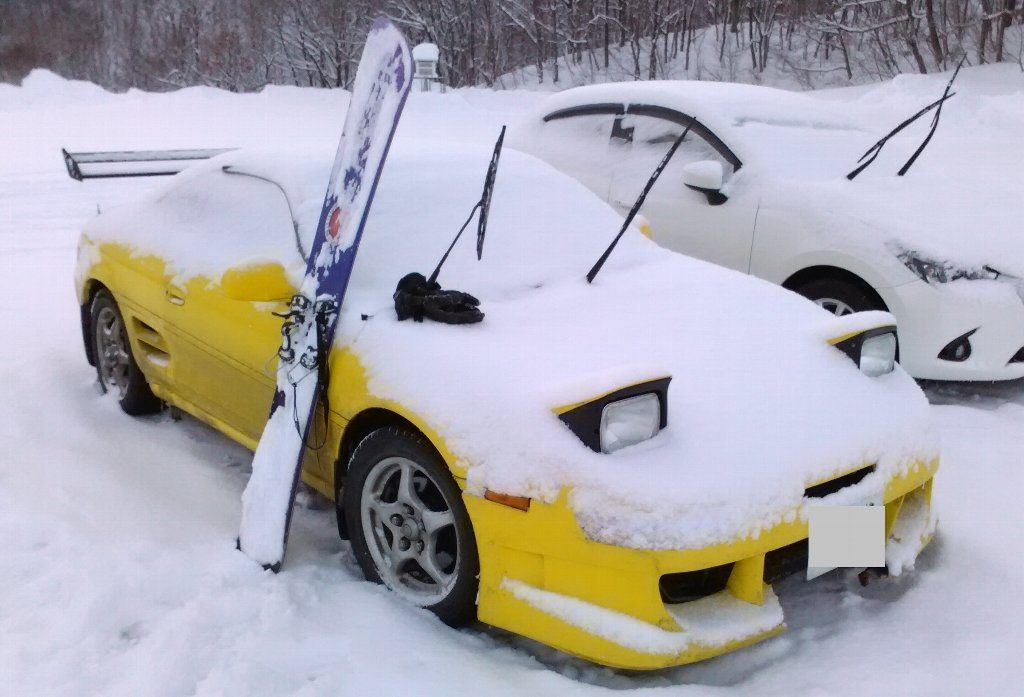
MR2 and Monoski

snowmen
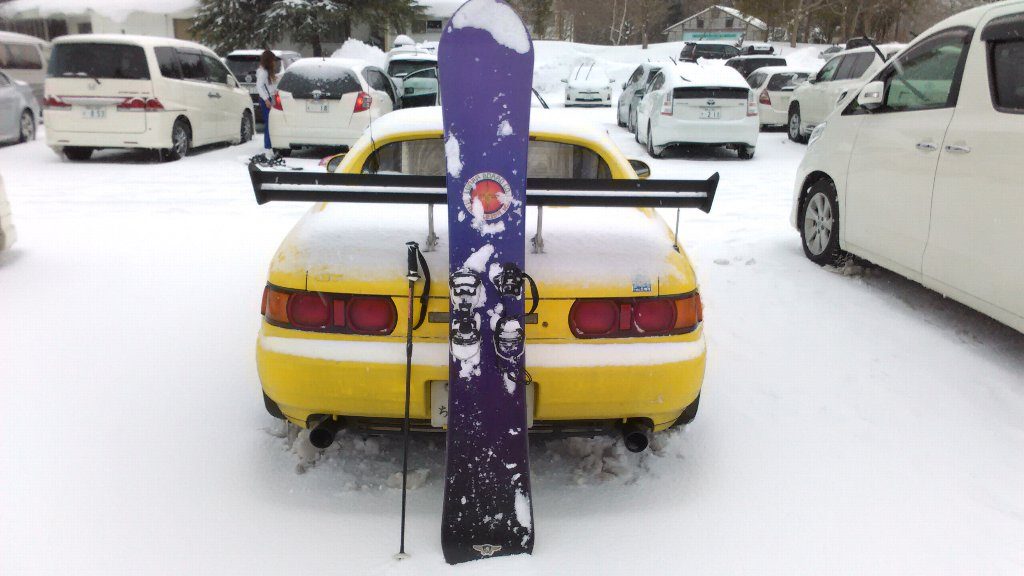

roll cakes
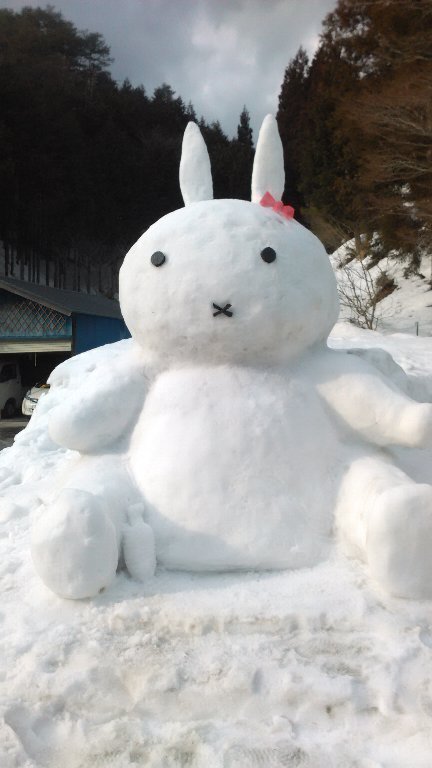
Miffy. It was not at ski area, but in front of a private house near ski area.
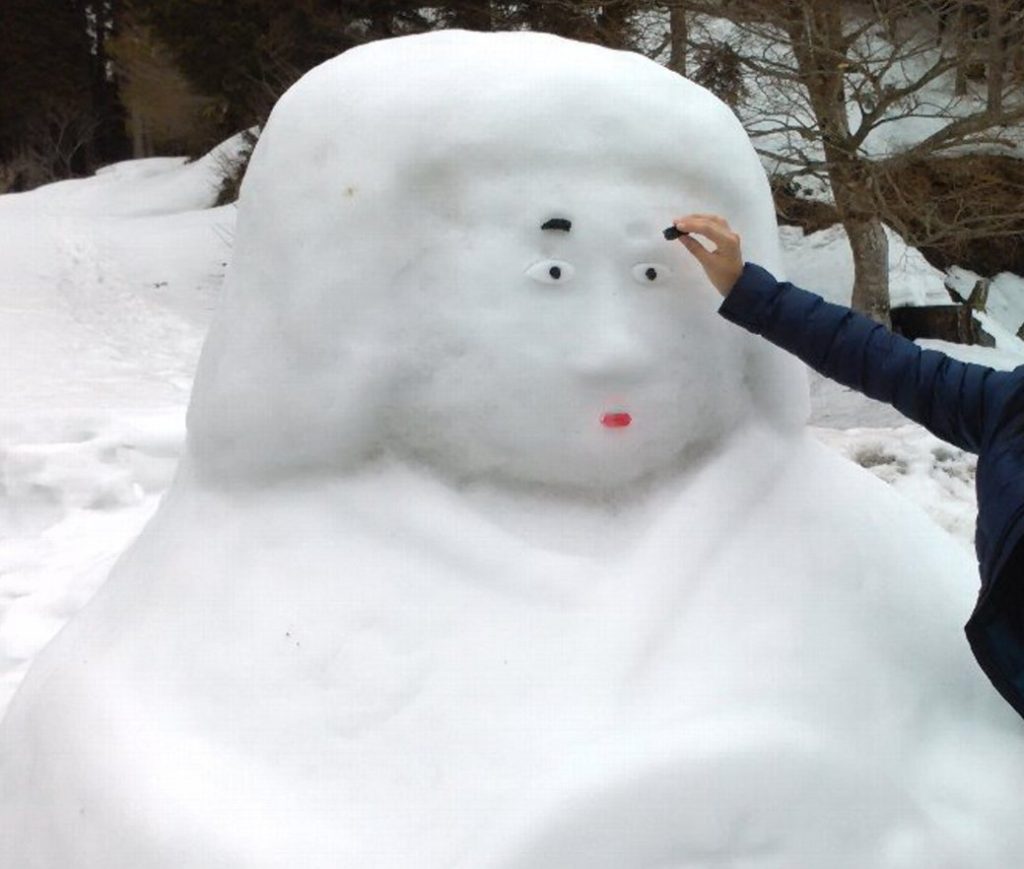
“Ohina-sama”. Doll which is decorated at “Hina-maturi” festival at March 3rd in Japan. It’s a product of inhabitant of the same house. As an eye brow has dropped, my daughter has attached.
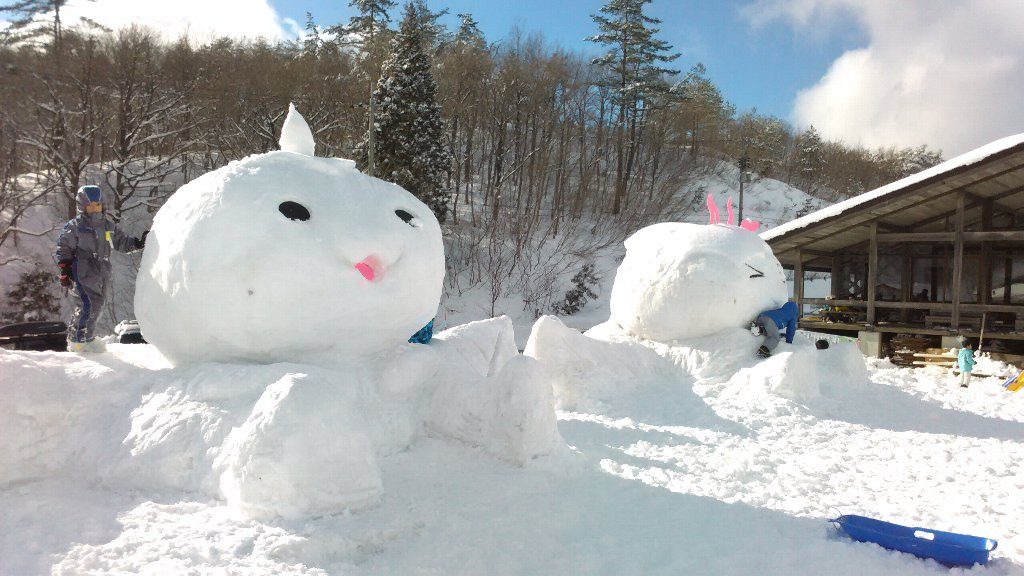
At “Hyomon-maturi” festival of Ombara ski area.
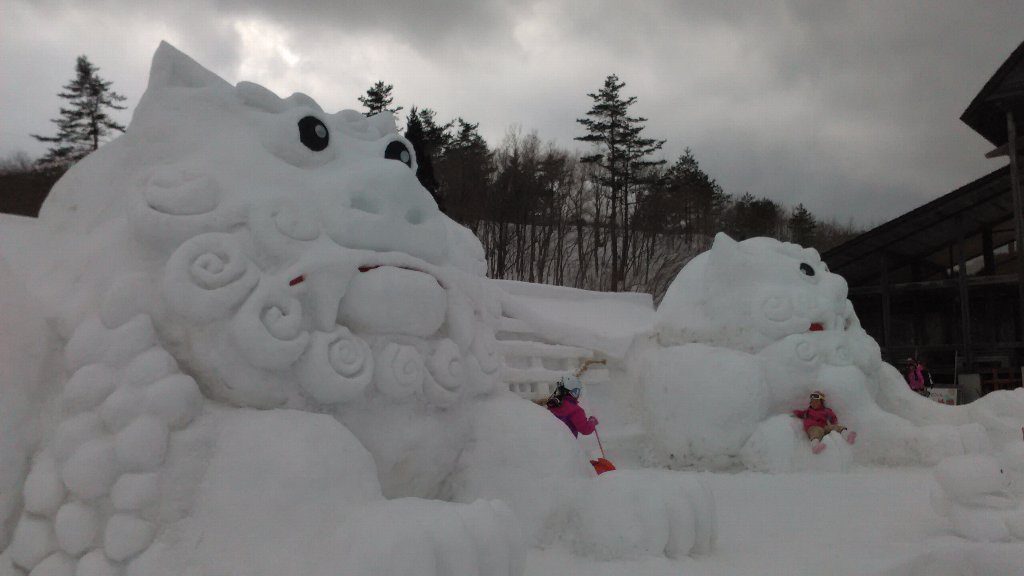
At also “Hyomon-maturi”.
Ombara ski area
It’s a favorite ski area where “Ojisan” often go.
I videod there.
There are two areas, “Panorama slopes” and “Lake side slopes”.
They are connected on the top.
“Ojisan” often use “Lake side slopes” as it is near from parking lot and rest house is not so crowded.
Why named lake side?
Because it’s near from “Ombara Lake”!
You can see the lake from the top of slope.
Please talk to “Ojisan” who are Monoskiing if you see. (^^)
It’s me!
Ombara ski area (Sorry but a Japanese page)

Editor’s postscript
Articles in grammer (a, an, the)
They are very difficult and troublesome to us Japanese.
Because we never have articles in Japanese.
I’m afraid that I’ve wrote too many “articles” in this page.
Especially “the’s”. (^^)
Please don’t mind of them. =^^=
Daily conversation and composition
Actually daily conversations and compositions are difficult for the ones who use foreign languages.
Logical sentences are easier.
English is not difficult?
Then please try to learn Japanese.
They are very different from each other.
European languages have common mother language.
You Indo-Europeans use languages which are from Proto-Indo-European language.
They resembles each other.
There are many common words.
You can often guess other languages or words in Europe.
Anyway, I hope you can understand my strange Japanglish. (^^)
Please guess. =^^=
And hope to have interest in Monoski!
It’s not all.
It’s only the introduction and entrance to Monoski.
But I stop it around here.
See ya!
Popular article
It’s written only in Japanese.
But you can see it by photos, illustrations and videos, I hope. =^^=
Why not see it, and try it!?
And imagination is very important!
Please imagine!

